Global Corporate Strategy for Volkswagen: Strategies, CSR, and Recruitment Issues
VerifiedAdded on 2023/06/03
|20
|5494
|256
AI Summary
The report discusses the strategies, CSR, and recruitment issues in Volkswagen to improve their competitiveness at a global level. It evaluates the internal situation of the firm and offers financial services, insurance, and banking services to their specified consumers. The report highlights the importance of brand trust and analyzes the external factors by Porter's five forces model.
Contribute Materials
Your contribution can guide someone’s learning journey. Share your
documents today.
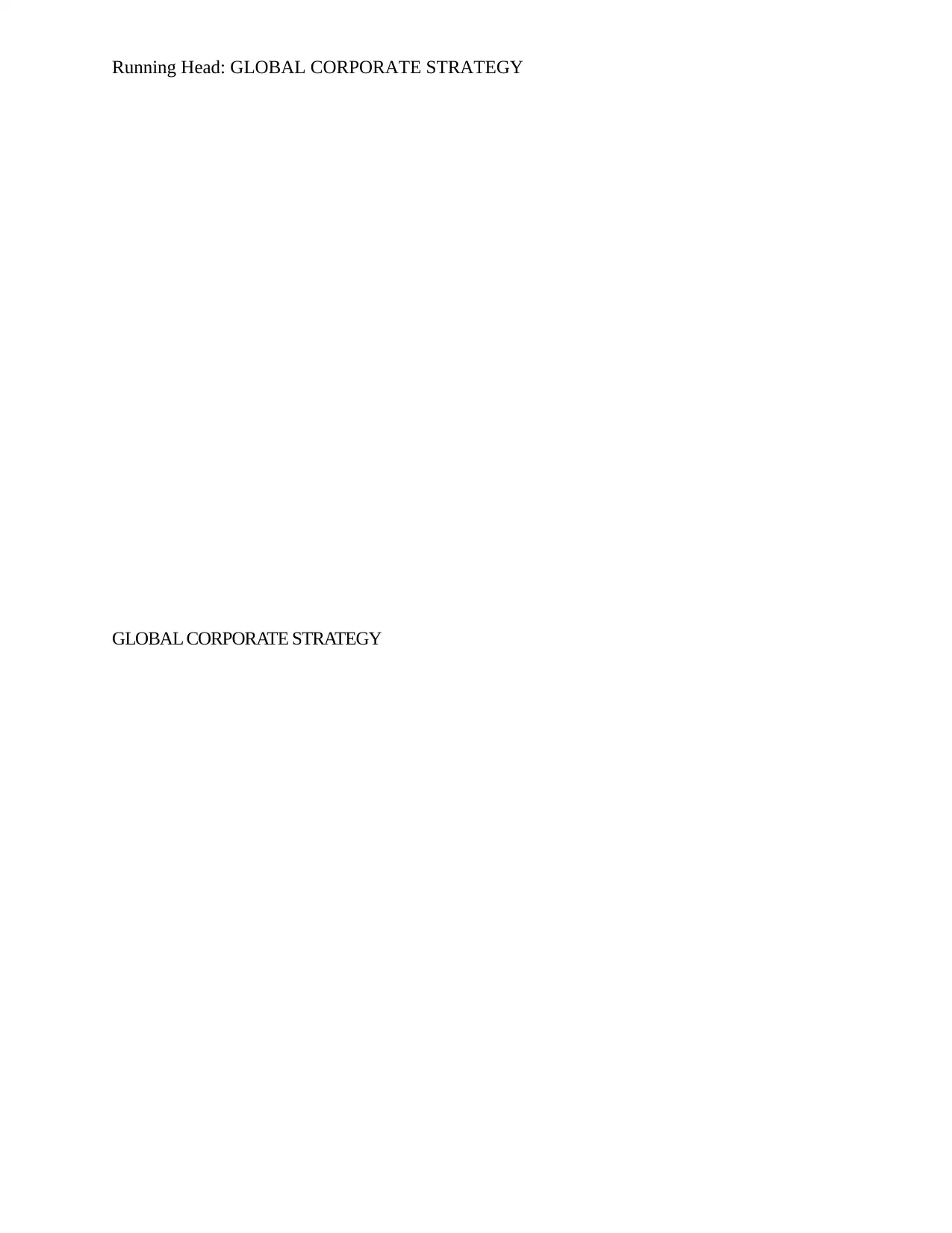
Running Head: GLOBAL CORPORATE STRATEGY
GLOBAL CORPORATE STRATEGY
GLOBAL CORPORATE STRATEGY
Secure Best Marks with AI Grader
Need help grading? Try our AI Grader for instant feedback on your assignments.
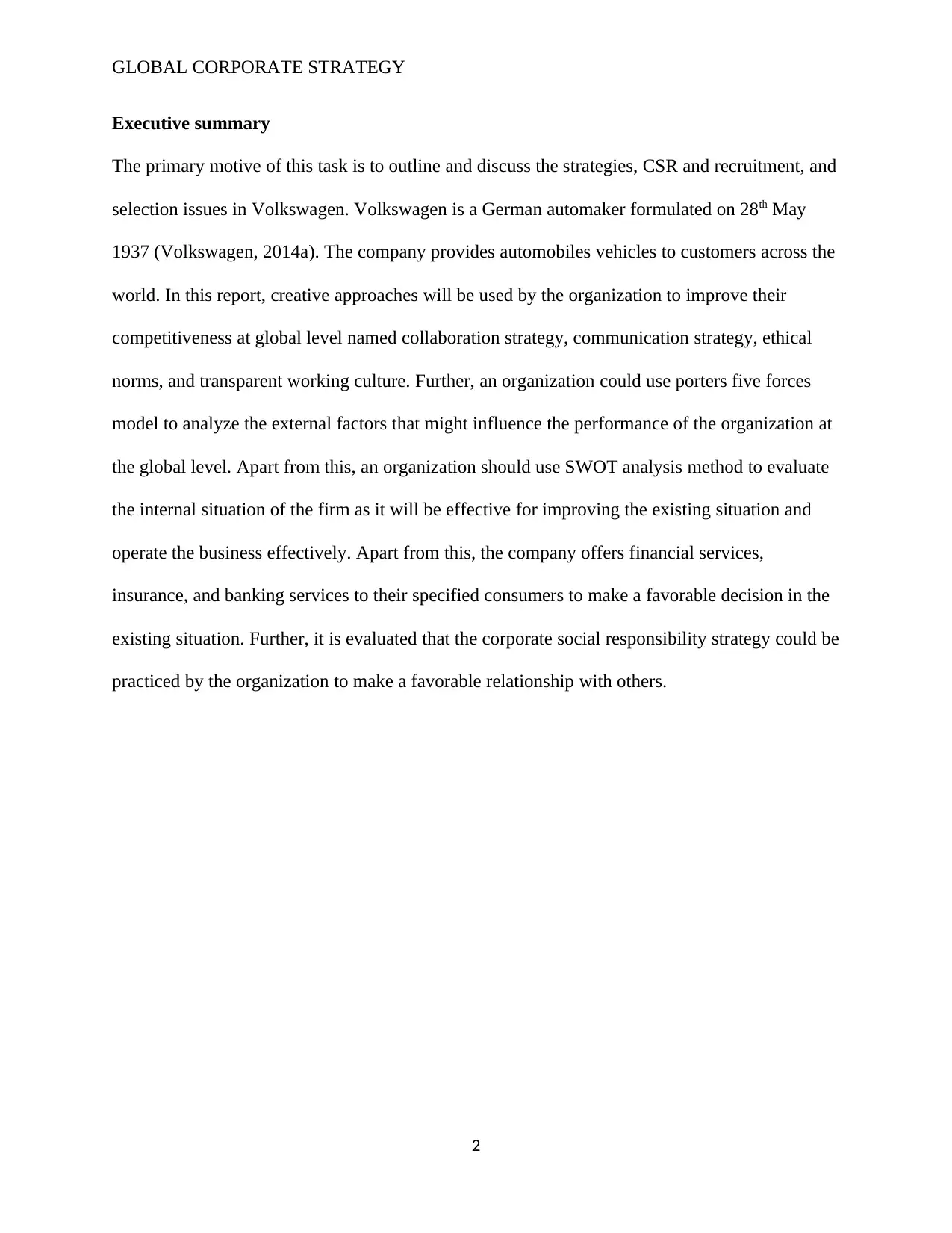
GLOBAL CORPORATE STRATEGY
Executive summary
The primary motive of this task is to outline and discuss the strategies, CSR and recruitment, and
selection issues in Volkswagen. Volkswagen is a German automaker formulated on 28th May
1937 (Volkswagen, 2014a). The company provides automobiles vehicles to customers across the
world. In this report, creative approaches will be used by the organization to improve their
competitiveness at global level named collaboration strategy, communication strategy, ethical
norms, and transparent working culture. Further, an organization could use porters five forces
model to analyze the external factors that might influence the performance of the organization at
the global level. Apart from this, an organization should use SWOT analysis method to evaluate
the internal situation of the firm as it will be effective for improving the existing situation and
operate the business effectively. Apart from this, the company offers financial services,
insurance, and banking services to their specified consumers to make a favorable decision in the
existing situation. Further, it is evaluated that the corporate social responsibility strategy could be
practiced by the organization to make a favorable relationship with others.
2
Executive summary
The primary motive of this task is to outline and discuss the strategies, CSR and recruitment, and
selection issues in Volkswagen. Volkswagen is a German automaker formulated on 28th May
1937 (Volkswagen, 2014a). The company provides automobiles vehicles to customers across the
world. In this report, creative approaches will be used by the organization to improve their
competitiveness at global level named collaboration strategy, communication strategy, ethical
norms, and transparent working culture. Further, an organization could use porters five forces
model to analyze the external factors that might influence the performance of the organization at
the global level. Apart from this, an organization should use SWOT analysis method to evaluate
the internal situation of the firm as it will be effective for improving the existing situation and
operate the business effectively. Apart from this, the company offers financial services,
insurance, and banking services to their specified consumers to make a favorable decision in the
existing situation. Further, it is evaluated that the corporate social responsibility strategy could be
practiced by the organization to make a favorable relationship with others.
2
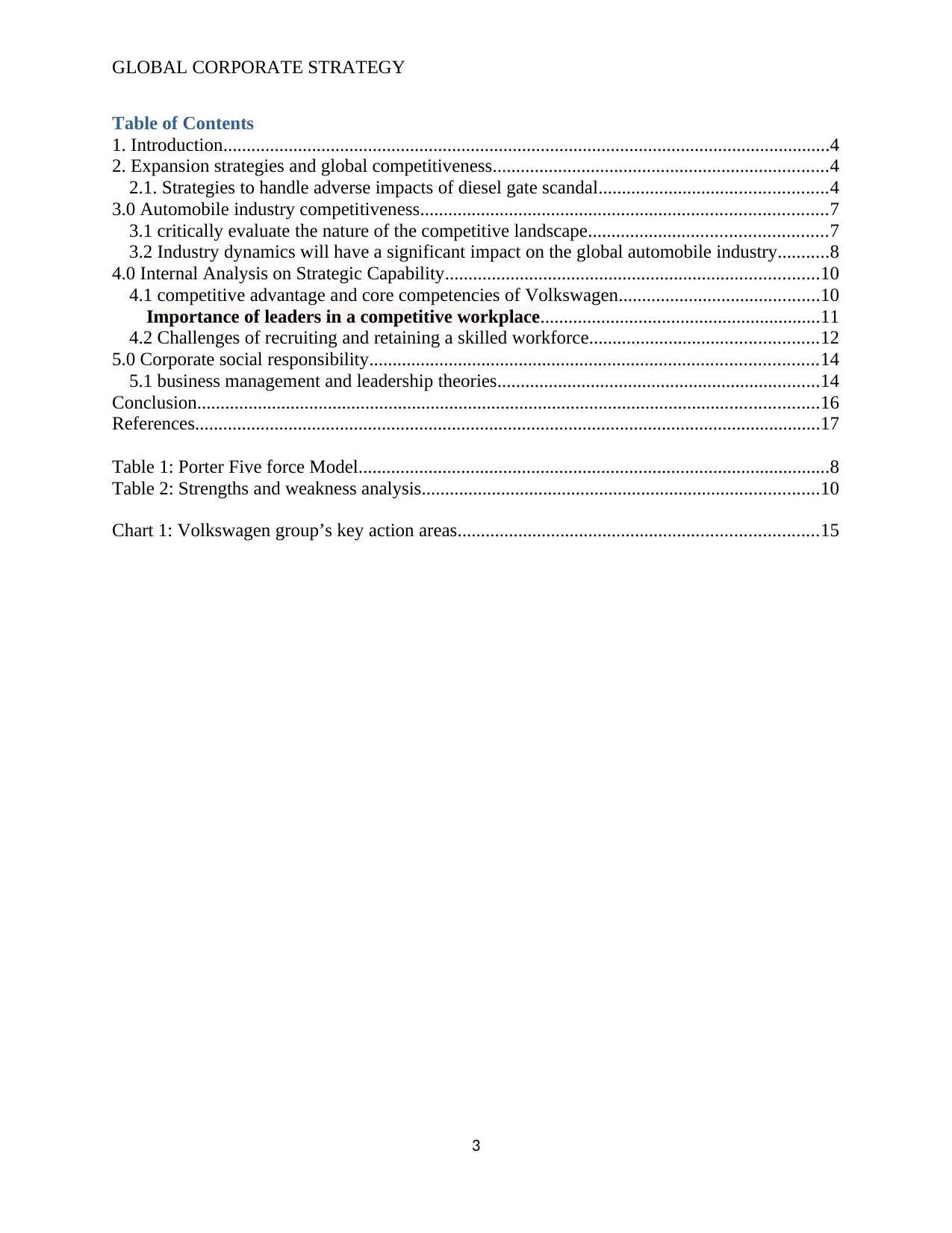
GLOBAL CORPORATE STRATEGY
Table of Contents
1. Introduction..................................................................................................................................4
2. Expansion strategies and global competitiveness........................................................................4
2.1. Strategies to handle adverse impacts of diesel gate scandal.................................................4
3.0 Automobile industry competitiveness.......................................................................................7
3.1 critically evaluate the nature of the competitive landscape...................................................7
3.2 Industry dynamics will have a significant impact on the global automobile industry...........8
4.0 Internal Analysis on Strategic Capability................................................................................10
4.1 competitive advantage and core competencies of Volkswagen...........................................10
Importance of leaders in a competitive workplace............................................................11
4.2 Challenges of recruiting and retaining a skilled workforce.................................................12
5.0 Corporate social responsibility................................................................................................14
5.1 business management and leadership theories.....................................................................14
Conclusion.....................................................................................................................................16
References......................................................................................................................................17
Table 1: Porter Five force Model.....................................................................................................8
Table 2: Strengths and weakness analysis.....................................................................................10
Chart 1: Volkswagen group’s key action areas.............................................................................15
3
Table of Contents
1. Introduction..................................................................................................................................4
2. Expansion strategies and global competitiveness........................................................................4
2.1. Strategies to handle adverse impacts of diesel gate scandal.................................................4
3.0 Automobile industry competitiveness.......................................................................................7
3.1 critically evaluate the nature of the competitive landscape...................................................7
3.2 Industry dynamics will have a significant impact on the global automobile industry...........8
4.0 Internal Analysis on Strategic Capability................................................................................10
4.1 competitive advantage and core competencies of Volkswagen...........................................10
Importance of leaders in a competitive workplace............................................................11
4.2 Challenges of recruiting and retaining a skilled workforce.................................................12
5.0 Corporate social responsibility................................................................................................14
5.1 business management and leadership theories.....................................................................14
Conclusion.....................................................................................................................................16
References......................................................................................................................................17
Table 1: Porter Five force Model.....................................................................................................8
Table 2: Strengths and weakness analysis.....................................................................................10
Chart 1: Volkswagen group’s key action areas.............................................................................15
3
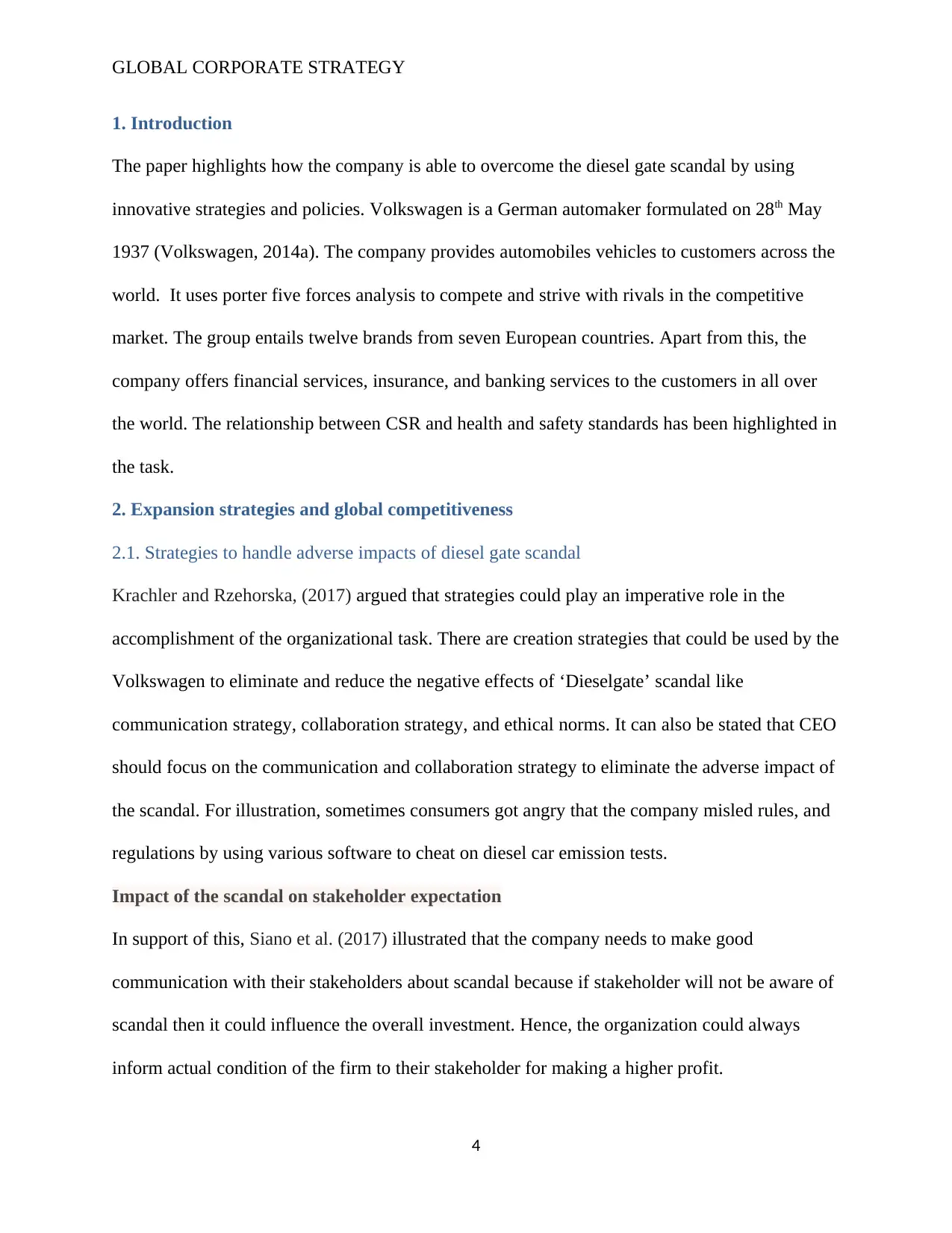
GLOBAL CORPORATE STRATEGY
1. Introduction
The paper highlights how the company is able to overcome the diesel gate scandal by using
innovative strategies and policies. Volkswagen is a German automaker formulated on 28th May
1937 (Volkswagen, 2014a). The company provides automobiles vehicles to customers across the
world. It uses porter five forces analysis to compete and strive with rivals in the competitive
market. The group entails twelve brands from seven European countries. Apart from this, the
company offers financial services, insurance, and banking services to the customers in all over
the world. The relationship between CSR and health and safety standards has been highlighted in
the task.
2. Expansion strategies and global competitiveness
2.1. Strategies to handle adverse impacts of diesel gate scandal
Krachler and Rzehorska, (2017) argued that strategies could play an imperative role in the
accomplishment of the organizational task. There are creation strategies that could be used by the
Volkswagen to eliminate and reduce the negative effects of ‘Dieselgate’ scandal like
communication strategy, collaboration strategy, and ethical norms. It can also be stated that CEO
should focus on the communication and collaboration strategy to eliminate the adverse impact of
the scandal. For illustration, sometimes consumers got angry that the company misled rules, and
regulations by using various software to cheat on diesel car emission tests.
Impact of the scandal on stakeholder expectation
In support of this, Siano et al. (2017) illustrated that the company needs to make good
communication with their stakeholders about scandal because if stakeholder will not be aware of
scandal then it could influence the overall investment. Hence, the organization could always
inform actual condition of the firm to their stakeholder for making a higher profit.
4
1. Introduction
The paper highlights how the company is able to overcome the diesel gate scandal by using
innovative strategies and policies. Volkswagen is a German automaker formulated on 28th May
1937 (Volkswagen, 2014a). The company provides automobiles vehicles to customers across the
world. It uses porter five forces analysis to compete and strive with rivals in the competitive
market. The group entails twelve brands from seven European countries. Apart from this, the
company offers financial services, insurance, and banking services to the customers in all over
the world. The relationship between CSR and health and safety standards has been highlighted in
the task.
2. Expansion strategies and global competitiveness
2.1. Strategies to handle adverse impacts of diesel gate scandal
Krachler and Rzehorska, (2017) argued that strategies could play an imperative role in the
accomplishment of the organizational task. There are creation strategies that could be used by the
Volkswagen to eliminate and reduce the negative effects of ‘Dieselgate’ scandal like
communication strategy, collaboration strategy, and ethical norms. It can also be stated that CEO
should focus on the communication and collaboration strategy to eliminate the adverse impact of
the scandal. For illustration, sometimes consumers got angry that the company misled rules, and
regulations by using various software to cheat on diesel car emission tests.
Impact of the scandal on stakeholder expectation
In support of this, Siano et al. (2017) illustrated that the company needs to make good
communication with their stakeholders about scandal because if stakeholder will not be aware of
scandal then it could influence the overall investment. Hence, the organization could always
inform actual condition of the firm to their stakeholder for making a higher profit.
4
Secure Best Marks with AI Grader
Need help grading? Try our AI Grader for instant feedback on your assignments.
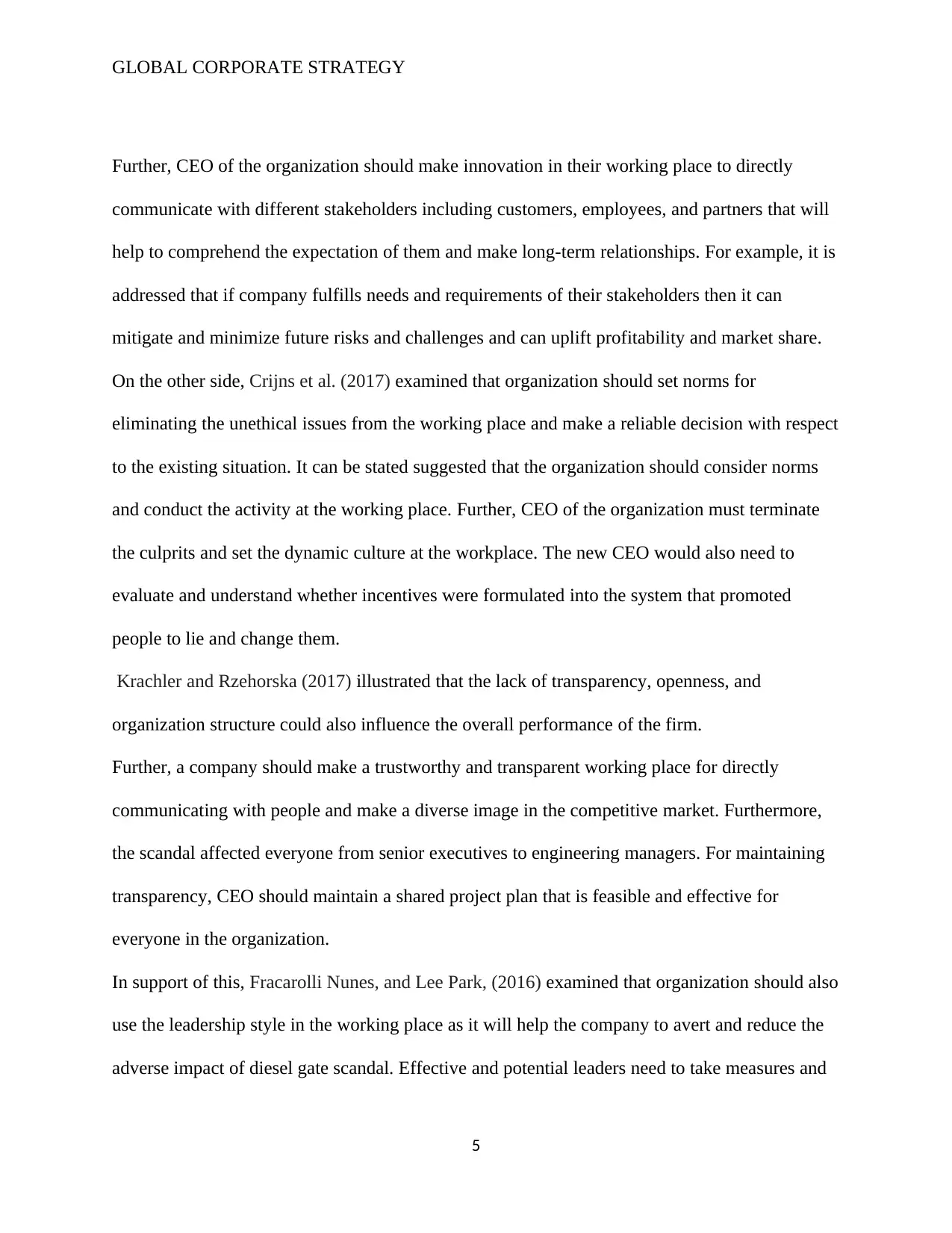
GLOBAL CORPORATE STRATEGY
Further, CEO of the organization should make innovation in their working place to directly
communicate with different stakeholders including customers, employees, and partners that will
help to comprehend the expectation of them and make long-term relationships. For example, it is
addressed that if company fulfills needs and requirements of their stakeholders then it can
mitigate and minimize future risks and challenges and can uplift profitability and market share.
On the other side, Crijns et al. (2017) examined that organization should set norms for
eliminating the unethical issues from the working place and make a reliable decision with respect
to the existing situation. It can be stated suggested that the organization should consider norms
and conduct the activity at the working place. Further, CEO of the organization must terminate
the culprits and set the dynamic culture at the workplace. The new CEO would also need to
evaluate and understand whether incentives were formulated into the system that promoted
people to lie and change them.
Krachler and Rzehorska (2017) illustrated that the lack of transparency, openness, and
organization structure could also influence the overall performance of the firm.
Further, a company should make a trustworthy and transparent working place for directly
communicating with people and make a diverse image in the competitive market. Furthermore,
the scandal affected everyone from senior executives to engineering managers. For maintaining
transparency, CEO should maintain a shared project plan that is feasible and effective for
everyone in the organization.
In support of this, Fracarolli Nunes, and Lee Park, (2016) examined that organization should also
use the leadership style in the working place as it will help the company to avert and reduce the
adverse impact of diesel gate scandal. Effective and potential leaders need to take measures and
5
Further, CEO of the organization should make innovation in their working place to directly
communicate with different stakeholders including customers, employees, and partners that will
help to comprehend the expectation of them and make long-term relationships. For example, it is
addressed that if company fulfills needs and requirements of their stakeholders then it can
mitigate and minimize future risks and challenges and can uplift profitability and market share.
On the other side, Crijns et al. (2017) examined that organization should set norms for
eliminating the unethical issues from the working place and make a reliable decision with respect
to the existing situation. It can be stated suggested that the organization should consider norms
and conduct the activity at the working place. Further, CEO of the organization must terminate
the culprits and set the dynamic culture at the workplace. The new CEO would also need to
evaluate and understand whether incentives were formulated into the system that promoted
people to lie and change them.
Krachler and Rzehorska (2017) illustrated that the lack of transparency, openness, and
organization structure could also influence the overall performance of the firm.
Further, a company should make a trustworthy and transparent working place for directly
communicating with people and make a diverse image in the competitive market. Furthermore,
the scandal affected everyone from senior executives to engineering managers. For maintaining
transparency, CEO should maintain a shared project plan that is feasible and effective for
everyone in the organization.
In support of this, Fracarolli Nunes, and Lee Park, (2016) examined that organization should also
use the leadership style in the working place as it will help the company to avert and reduce the
adverse impact of diesel gate scandal. Effective and potential leaders need to take measures and
5
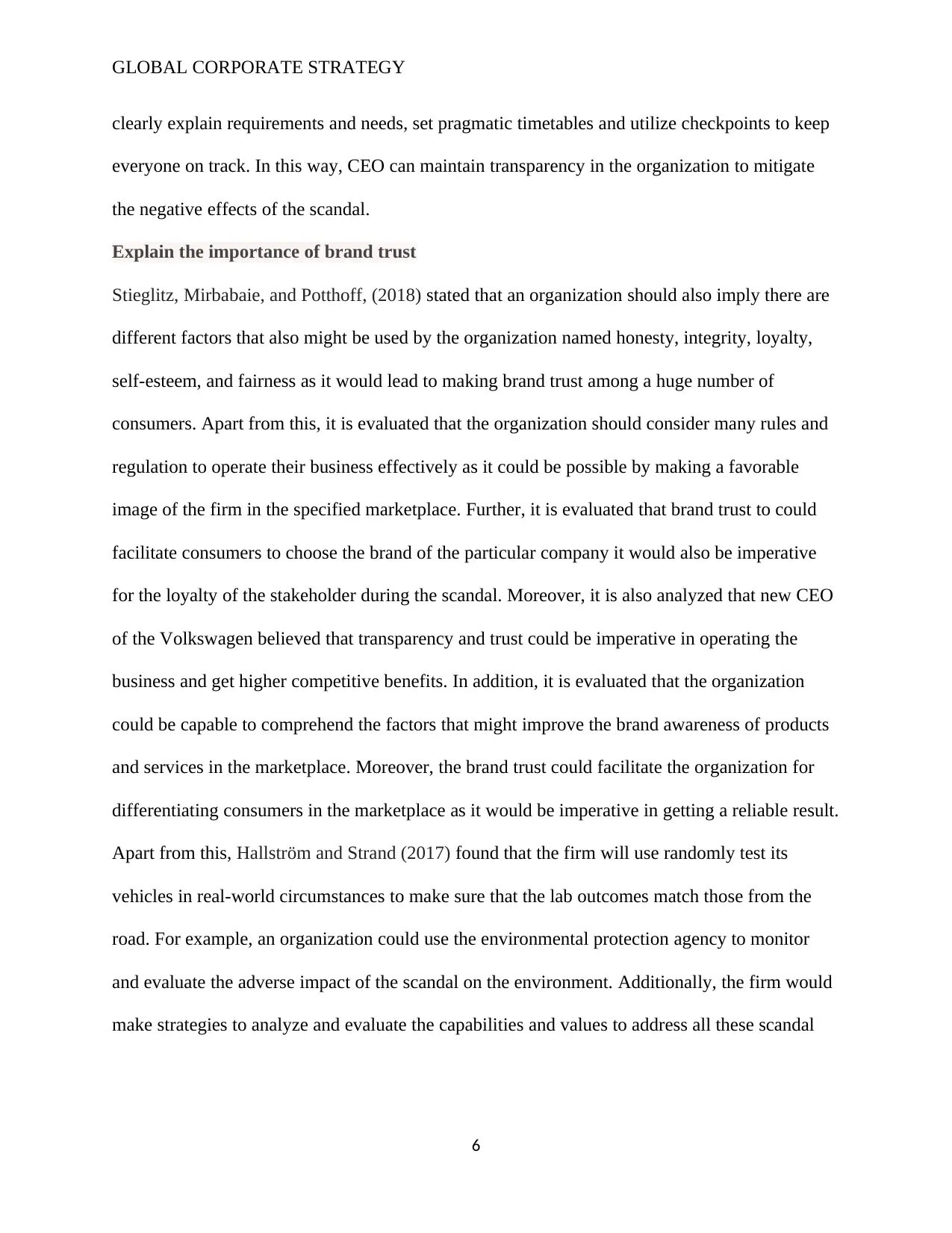
GLOBAL CORPORATE STRATEGY
clearly explain requirements and needs, set pragmatic timetables and utilize checkpoints to keep
everyone on track. In this way, CEO can maintain transparency in the organization to mitigate
the negative effects of the scandal.
Explain the importance of brand trust
Stieglitz, Mirbabaie, and Potthoff, (2018) stated that an organization should also imply there are
different factors that also might be used by the organization named honesty, integrity, loyalty,
self-esteem, and fairness as it would lead to making brand trust among a huge number of
consumers. Apart from this, it is evaluated that the organization should consider many rules and
regulation to operate their business effectively as it could be possible by making a favorable
image of the firm in the specified marketplace. Further, it is evaluated that brand trust to could
facilitate consumers to choose the brand of the particular company it would also be imperative
for the loyalty of the stakeholder during the scandal. Moreover, it is also analyzed that new CEO
of the Volkswagen believed that transparency and trust could be imperative in operating the
business and get higher competitive benefits. In addition, it is evaluated that the organization
could be capable to comprehend the factors that might improve the brand awareness of products
and services in the marketplace. Moreover, the brand trust could facilitate the organization for
differentiating consumers in the marketplace as it would be imperative in getting a reliable result.
Apart from this, Hallström and Strand (2017) found that the firm will use randomly test its
vehicles in real-world circumstances to make sure that the lab outcomes match those from the
road. For example, an organization could use the environmental protection agency to monitor
and evaluate the adverse impact of the scandal on the environment. Additionally, the firm would
make strategies to analyze and evaluate the capabilities and values to address all these scandal
6
clearly explain requirements and needs, set pragmatic timetables and utilize checkpoints to keep
everyone on track. In this way, CEO can maintain transparency in the organization to mitigate
the negative effects of the scandal.
Explain the importance of brand trust
Stieglitz, Mirbabaie, and Potthoff, (2018) stated that an organization should also imply there are
different factors that also might be used by the organization named honesty, integrity, loyalty,
self-esteem, and fairness as it would lead to making brand trust among a huge number of
consumers. Apart from this, it is evaluated that the organization should consider many rules and
regulation to operate their business effectively as it could be possible by making a favorable
image of the firm in the specified marketplace. Further, it is evaluated that brand trust to could
facilitate consumers to choose the brand of the particular company it would also be imperative
for the loyalty of the stakeholder during the scandal. Moreover, it is also analyzed that new CEO
of the Volkswagen believed that transparency and trust could be imperative in operating the
business and get higher competitive benefits. In addition, it is evaluated that the organization
could be capable to comprehend the factors that might improve the brand awareness of products
and services in the marketplace. Moreover, the brand trust could facilitate the organization for
differentiating consumers in the marketplace as it would be imperative in getting a reliable result.
Apart from this, Hallström and Strand (2017) found that the firm will use randomly test its
vehicles in real-world circumstances to make sure that the lab outcomes match those from the
road. For example, an organization could use the environmental protection agency to monitor
and evaluate the adverse impact of the scandal on the environment. Additionally, the firm would
make strategies to analyze and evaluate the capabilities and values to address all these scandal
6

GLOBAL CORPORATE STRATEGY
issues and challenges. It will help the company to improve and enhance the business
performance and productivity in the international market.
3.0 Automobile industry competitiveness
3.1 critically evaluate the nature of the competitive landscape
Spapens, (2018) argued that the industry life cycle could be imperative in evaluating the
competitiveness of the industry as it could consider certain stages named introduction, growth,
maturity, and decline. The entity is currently on the maturity stage in terms of the products
offered. The main purpose of implying the competitive strategy is that as it allows to increase the
sale of the organization and make their unique image in the marketplace. Further, the next step is
to expand strategies to other regions, through the product and brand differentiation. Further, the
sharing of the PPE production platform for electric cars saves the development cost (at the
introduction stage of the life cycle). Thus, the distinction of the brands can be said to be the chief
strategy of the Volkswagen company.
In support of this, Luthra, Garg, and Haleem, (2015) stated that globalization has posed two main
challenges on the lines of the pollution for the automotive industry as a whole. These are the
strict emission tests and the ongoing global trade tensions. It is important to note that the chief
plant of Wolfsburg is set to be closed in order to align the same with the new EU emission tests
that are based on the mimicking the real-life driving conditions instead of only lab tests as
conducted earlier. These are introduced by the Worldwide harmonized Light vehicles Test
Procedure (WLPT).
Impact on the retailing. eg. raw materials, cost, and general strategy
Luthra, Garg, and Haleem, (2016) illustrated that there are certain components that might be
considered by the firm named raw materials, general strategy, and cost due to improving their
7
issues and challenges. It will help the company to improve and enhance the business
performance and productivity in the international market.
3.0 Automobile industry competitiveness
3.1 critically evaluate the nature of the competitive landscape
Spapens, (2018) argued that the industry life cycle could be imperative in evaluating the
competitiveness of the industry as it could consider certain stages named introduction, growth,
maturity, and decline. The entity is currently on the maturity stage in terms of the products
offered. The main purpose of implying the competitive strategy is that as it allows to increase the
sale of the organization and make their unique image in the marketplace. Further, the next step is
to expand strategies to other regions, through the product and brand differentiation. Further, the
sharing of the PPE production platform for electric cars saves the development cost (at the
introduction stage of the life cycle). Thus, the distinction of the brands can be said to be the chief
strategy of the Volkswagen company.
In support of this, Luthra, Garg, and Haleem, (2015) stated that globalization has posed two main
challenges on the lines of the pollution for the automotive industry as a whole. These are the
strict emission tests and the ongoing global trade tensions. It is important to note that the chief
plant of Wolfsburg is set to be closed in order to align the same with the new EU emission tests
that are based on the mimicking the real-life driving conditions instead of only lab tests as
conducted earlier. These are introduced by the Worldwide harmonized Light vehicles Test
Procedure (WLPT).
Impact on the retailing. eg. raw materials, cost, and general strategy
Luthra, Garg, and Haleem, (2016) illustrated that there are certain components that might be
considered by the firm named raw materials, general strategy, and cost due to improving their
7
Paraphrase This Document
Need a fresh take? Get an instant paraphrase of this document with our AI Paraphraser
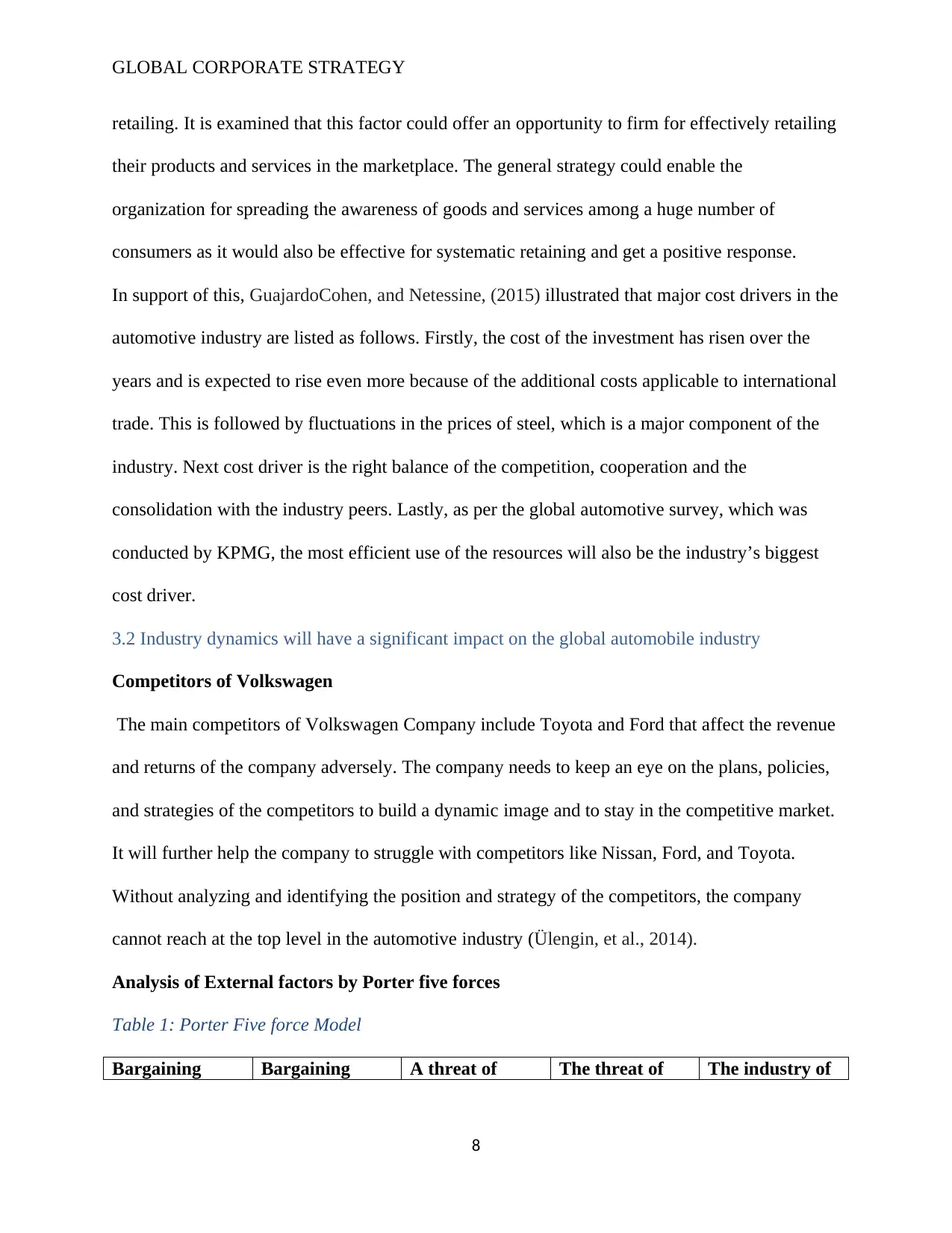
GLOBAL CORPORATE STRATEGY
retailing. It is examined that this factor could offer an opportunity to firm for effectively retailing
their products and services in the marketplace. The general strategy could enable the
organization for spreading the awareness of goods and services among a huge number of
consumers as it would also be effective for systematic retaining and get a positive response.
In support of this, GuajardoCohen, and Netessine, (2015) illustrated that major cost drivers in the
automotive industry are listed as follows. Firstly, the cost of the investment has risen over the
years and is expected to rise even more because of the additional costs applicable to international
trade. This is followed by fluctuations in the prices of steel, which is a major component of the
industry. Next cost driver is the right balance of the competition, cooperation and the
consolidation with the industry peers. Lastly, as per the global automotive survey, which was
conducted by KPMG, the most efficient use of the resources will also be the industry’s biggest
cost driver.
3.2 Industry dynamics will have a significant impact on the global automobile industry
Competitors of Volkswagen
The main competitors of Volkswagen Company include Toyota and Ford that affect the revenue
and returns of the company adversely. The company needs to keep an eye on the plans, policies,
and strategies of the competitors to build a dynamic image and to stay in the competitive market.
It will further help the company to struggle with competitors like Nissan, Ford, and Toyota.
Without analyzing and identifying the position and strategy of the competitors, the company
cannot reach at the top level in the automotive industry (Ülengin, et al., 2014).
Analysis of External factors by Porter five forces
Table 1: Porter Five force Model
Bargaining Bargaining A threat of The threat of The industry of
8
retailing. It is examined that this factor could offer an opportunity to firm for effectively retailing
their products and services in the marketplace. The general strategy could enable the
organization for spreading the awareness of goods and services among a huge number of
consumers as it would also be effective for systematic retaining and get a positive response.
In support of this, GuajardoCohen, and Netessine, (2015) illustrated that major cost drivers in the
automotive industry are listed as follows. Firstly, the cost of the investment has risen over the
years and is expected to rise even more because of the additional costs applicable to international
trade. This is followed by fluctuations in the prices of steel, which is a major component of the
industry. Next cost driver is the right balance of the competition, cooperation and the
consolidation with the industry peers. Lastly, as per the global automotive survey, which was
conducted by KPMG, the most efficient use of the resources will also be the industry’s biggest
cost driver.
3.2 Industry dynamics will have a significant impact on the global automobile industry
Competitors of Volkswagen
The main competitors of Volkswagen Company include Toyota and Ford that affect the revenue
and returns of the company adversely. The company needs to keep an eye on the plans, policies,
and strategies of the competitors to build a dynamic image and to stay in the competitive market.
It will further help the company to struggle with competitors like Nissan, Ford, and Toyota.
Without analyzing and identifying the position and strategy of the competitors, the company
cannot reach at the top level in the automotive industry (Ülengin, et al., 2014).
Analysis of External factors by Porter five forces
Table 1: Porter Five force Model
Bargaining Bargaining A threat of The threat of The industry of
8
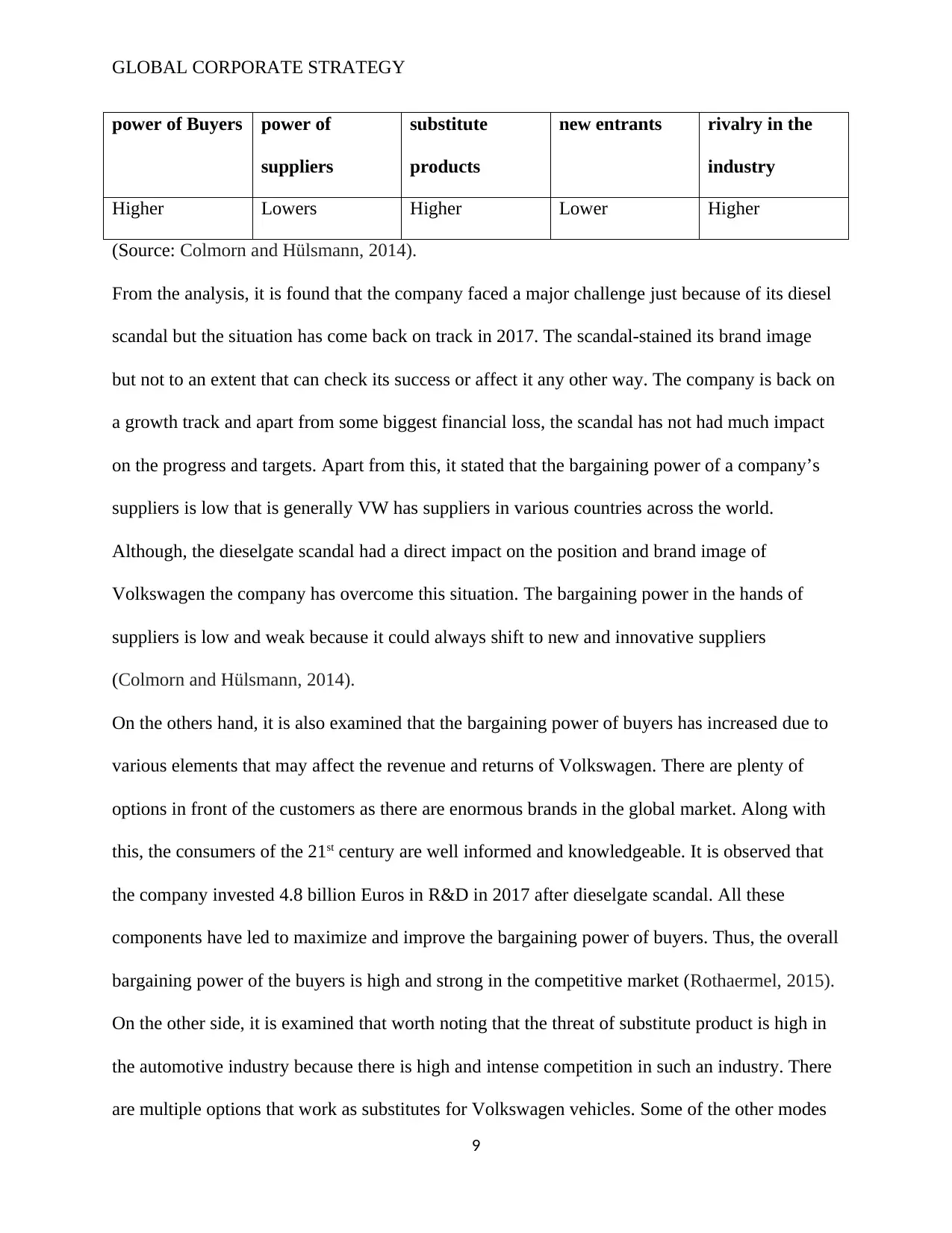
GLOBAL CORPORATE STRATEGY
power of Buyers power of
suppliers
substitute
products
new entrants rivalry in the
industry
Higher Lowers Higher Lower Higher
(Source: Colmorn and Hülsmann, 2014).
From the analysis, it is found that the company faced a major challenge just because of its diesel
scandal but the situation has come back on track in 2017. The scandal-stained its brand image
but not to an extent that can check its success or affect it any other way. The company is back on
a growth track and apart from some biggest financial loss, the scandal has not had much impact
on the progress and targets. Apart from this, it stated that the bargaining power of a company’s
suppliers is low that is generally VW has suppliers in various countries across the world.
Although, the dieselgate scandal had a direct impact on the position and brand image of
Volkswagen the company has overcome this situation. The bargaining power in the hands of
suppliers is low and weak because it could always shift to new and innovative suppliers
(Colmorn and Hülsmann, 2014).
On the others hand, it is also examined that the bargaining power of buyers has increased due to
various elements that may affect the revenue and returns of Volkswagen. There are plenty of
options in front of the customers as there are enormous brands in the global market. Along with
this, the consumers of the 21st century are well informed and knowledgeable. It is observed that
the company invested 4.8 billion Euros in R&D in 2017 after dieselgate scandal. All these
components have led to maximize and improve the bargaining power of buyers. Thus, the overall
bargaining power of the buyers is high and strong in the competitive market (Rothaermel, 2015).
On the other side, it is examined that worth noting that the threat of substitute product is high in
the automotive industry because there is high and intense competition in such an industry. There
are multiple options that work as substitutes for Volkswagen vehicles. Some of the other modes
9
power of Buyers power of
suppliers
substitute
products
new entrants rivalry in the
industry
Higher Lowers Higher Lower Higher
(Source: Colmorn and Hülsmann, 2014).
From the analysis, it is found that the company faced a major challenge just because of its diesel
scandal but the situation has come back on track in 2017. The scandal-stained its brand image
but not to an extent that can check its success or affect it any other way. The company is back on
a growth track and apart from some biggest financial loss, the scandal has not had much impact
on the progress and targets. Apart from this, it stated that the bargaining power of a company’s
suppliers is low that is generally VW has suppliers in various countries across the world.
Although, the dieselgate scandal had a direct impact on the position and brand image of
Volkswagen the company has overcome this situation. The bargaining power in the hands of
suppliers is low and weak because it could always shift to new and innovative suppliers
(Colmorn and Hülsmann, 2014).
On the others hand, it is also examined that the bargaining power of buyers has increased due to
various elements that may affect the revenue and returns of Volkswagen. There are plenty of
options in front of the customers as there are enormous brands in the global market. Along with
this, the consumers of the 21st century are well informed and knowledgeable. It is observed that
the company invested 4.8 billion Euros in R&D in 2017 after dieselgate scandal. All these
components have led to maximize and improve the bargaining power of buyers. Thus, the overall
bargaining power of the buyers is high and strong in the competitive market (Rothaermel, 2015).
On the other side, it is examined that worth noting that the threat of substitute product is high in
the automotive industry because there is high and intense competition in such an industry. There
are multiple options that work as substitutes for Volkswagen vehicles. Some of the other modes
9

GLOBAL CORPORATE STRATEGY
of public travel also act as alternatives for VW products. Thus, the entire threat of substitute is
moderate in the context of automotive products (Gao, et al., 2016).
In contrast to this, evaluated that threat of new entrants is weak and low in the automotive
industry because there are high barriers and challenges to entry that make it quite impossible for
any company to enter into the market while there is a wide range of investment in the
infrastructure such as supply chain, manufacturing, distribution, and marketing along with that,
there is high expenditure related to human resources (Qian, et al., 2015).
On the other hand, studied that the intensity of the rivalry is very high and immense in the
automotive industry. It can be noted that Volkswagen faces immense competition because of
other automobile organizations like Ford, Nissan, and Toyota are trying to penetrate its market
share in the automobile industry (Unsworth and McMillan, 2014).
4.0 Internal Analysis on Strategic Capability
4.1 competitive advantage and core competencies of Volkswagen
The organization could evaluate the strength and weaknesses to effectively comprehend the
internal situation of the Volkswagen and improve their weakness (Fang, et al, 2014). It would
also be imperative to improve the overall financial performance of the firm. It is discussed by the
following table:
Table 2: Strengths and weakness analysis
Strengths
Strong brand image
The higher range of products and
services
Higher market share
Weakness
Intense competition between
manufacturers and global organization
Lack of cultural understanding
Lack of skilled employees
10
of public travel also act as alternatives for VW products. Thus, the entire threat of substitute is
moderate in the context of automotive products (Gao, et al., 2016).
In contrast to this, evaluated that threat of new entrants is weak and low in the automotive
industry because there are high barriers and challenges to entry that make it quite impossible for
any company to enter into the market while there is a wide range of investment in the
infrastructure such as supply chain, manufacturing, distribution, and marketing along with that,
there is high expenditure related to human resources (Qian, et al., 2015).
On the other hand, studied that the intensity of the rivalry is very high and immense in the
automotive industry. It can be noted that Volkswagen faces immense competition because of
other automobile organizations like Ford, Nissan, and Toyota are trying to penetrate its market
share in the automobile industry (Unsworth and McMillan, 2014).
4.0 Internal Analysis on Strategic Capability
4.1 competitive advantage and core competencies of Volkswagen
The organization could evaluate the strength and weaknesses to effectively comprehend the
internal situation of the Volkswagen and improve their weakness (Fang, et al, 2014). It would
also be imperative to improve the overall financial performance of the firm. It is discussed by the
following table:
Table 2: Strengths and weakness analysis
Strengths
Strong brand image
The higher range of products and
services
Higher market share
Weakness
Intense competition between
manufacturers and global organization
Lack of cultural understanding
Lack of skilled employees
10
Secure Best Marks with AI Grader
Need help grading? Try our AI Grader for instant feedback on your assignments.
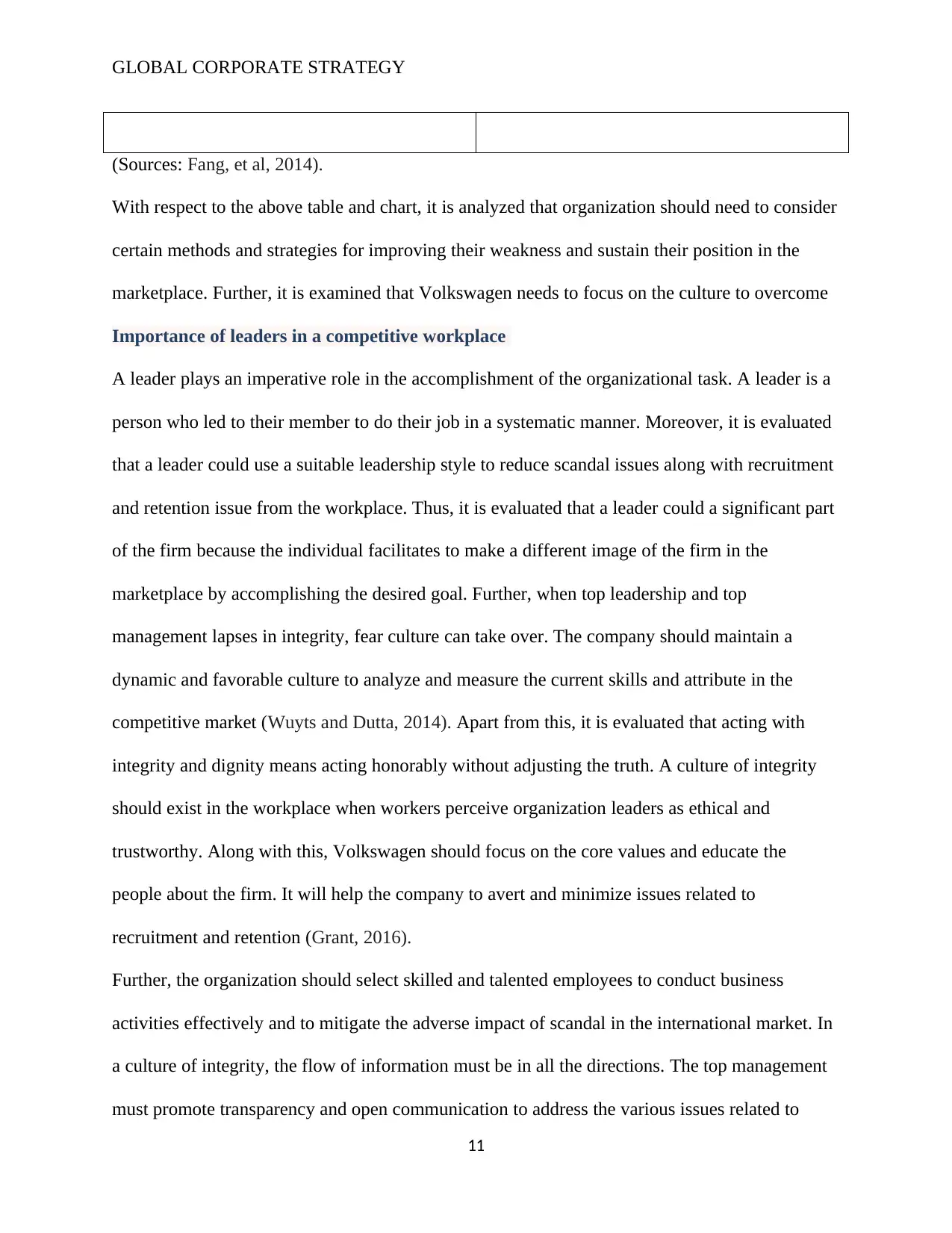
GLOBAL CORPORATE STRATEGY
(Sources: Fang, et al, 2014).
With respect to the above table and chart, it is analyzed that organization should need to consider
certain methods and strategies for improving their weakness and sustain their position in the
marketplace. Further, it is examined that Volkswagen needs to focus on the culture to overcome
Importance of leaders in a competitive workplace
A leader plays an imperative role in the accomplishment of the organizational task. A leader is a
person who led to their member to do their job in a systematic manner. Moreover, it is evaluated
that a leader could use a suitable leadership style to reduce scandal issues along with recruitment
and retention issue from the workplace. Thus, it is evaluated that a leader could a significant part
of the firm because the individual facilitates to make a different image of the firm in the
marketplace by accomplishing the desired goal. Further, when top leadership and top
management lapses in integrity, fear culture can take over. The company should maintain a
dynamic and favorable culture to analyze and measure the current skills and attribute in the
competitive market (Wuyts and Dutta, 2014). Apart from this, it is evaluated that acting with
integrity and dignity means acting honorably without adjusting the truth. A culture of integrity
should exist in the workplace when workers perceive organization leaders as ethical and
trustworthy. Along with this, Volkswagen should focus on the core values and educate the
people about the firm. It will help the company to avert and minimize issues related to
recruitment and retention (Grant, 2016).
Further, the organization should select skilled and talented employees to conduct business
activities effectively and to mitigate the adverse impact of scandal in the international market. In
a culture of integrity, the flow of information must be in all the directions. The top management
must promote transparency and open communication to address the various issues related to
11
(Sources: Fang, et al, 2014).
With respect to the above table and chart, it is analyzed that organization should need to consider
certain methods and strategies for improving their weakness and sustain their position in the
marketplace. Further, it is examined that Volkswagen needs to focus on the culture to overcome
Importance of leaders in a competitive workplace
A leader plays an imperative role in the accomplishment of the organizational task. A leader is a
person who led to their member to do their job in a systematic manner. Moreover, it is evaluated
that a leader could use a suitable leadership style to reduce scandal issues along with recruitment
and retention issue from the workplace. Thus, it is evaluated that a leader could a significant part
of the firm because the individual facilitates to make a different image of the firm in the
marketplace by accomplishing the desired goal. Further, when top leadership and top
management lapses in integrity, fear culture can take over. The company should maintain a
dynamic and favorable culture to analyze and measure the current skills and attribute in the
competitive market (Wuyts and Dutta, 2014). Apart from this, it is evaluated that acting with
integrity and dignity means acting honorably without adjusting the truth. A culture of integrity
should exist in the workplace when workers perceive organization leaders as ethical and
trustworthy. Along with this, Volkswagen should focus on the core values and educate the
people about the firm. It will help the company to avert and minimize issues related to
recruitment and retention (Grant, 2016).
Further, the organization should select skilled and talented employees to conduct business
activities effectively and to mitigate the adverse impact of scandal in the international market. In
a culture of integrity, the flow of information must be in all the directions. The top management
must promote transparency and open communication to address the various issues related to
11
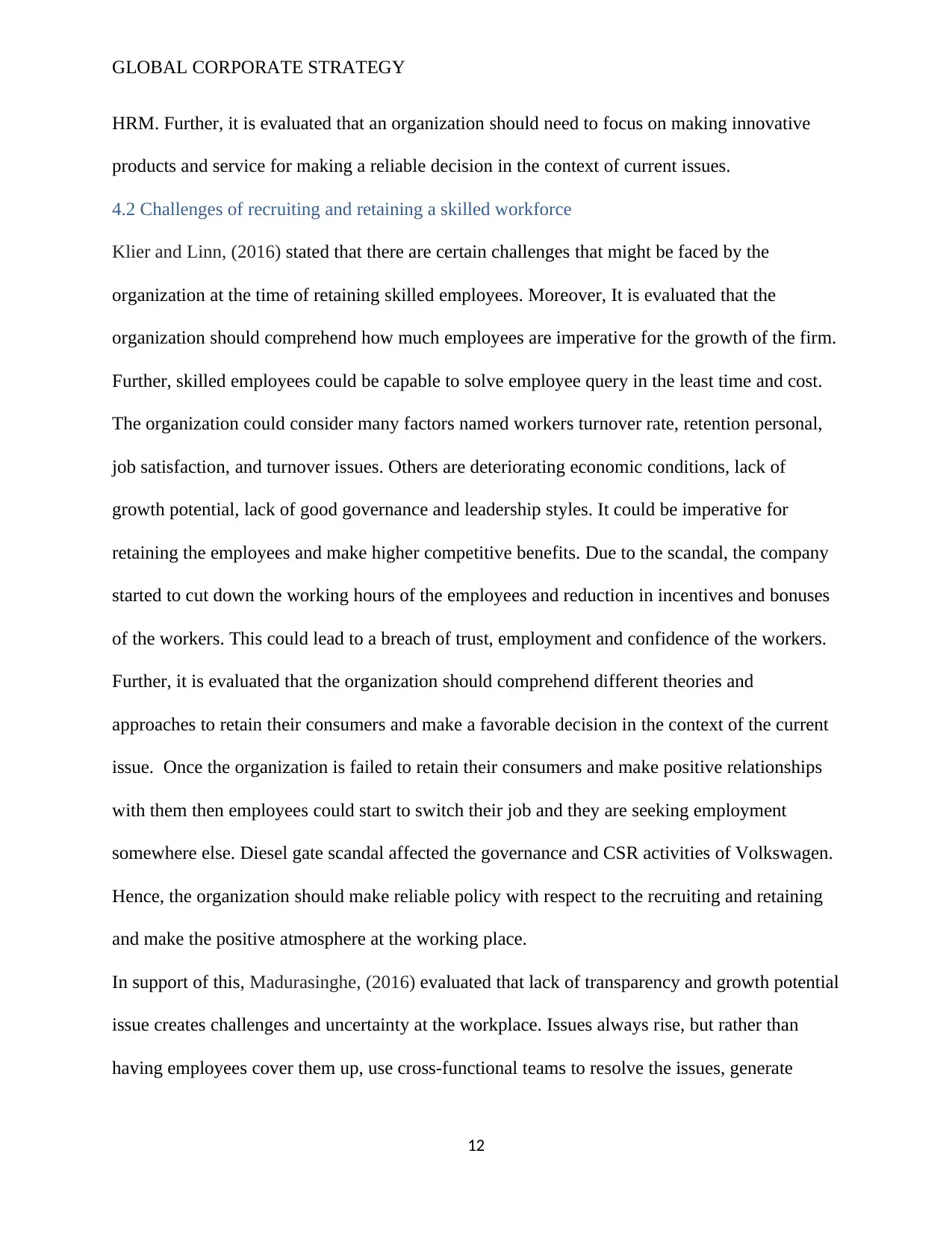
GLOBAL CORPORATE STRATEGY
HRM. Further, it is evaluated that an organization should need to focus on making innovative
products and service for making a reliable decision in the context of current issues.
4.2 Challenges of recruiting and retaining a skilled workforce
Klier and Linn, (2016) stated that there are certain challenges that might be faced by the
organization at the time of retaining skilled employees. Moreover, It is evaluated that the
organization should comprehend how much employees are imperative for the growth of the firm.
Further, skilled employees could be capable to solve employee query in the least time and cost.
The organization could consider many factors named workers turnover rate, retention personal,
job satisfaction, and turnover issues. Others are deteriorating economic conditions, lack of
growth potential, lack of good governance and leadership styles. It could be imperative for
retaining the employees and make higher competitive benefits. Due to the scandal, the company
started to cut down the working hours of the employees and reduction in incentives and bonuses
of the workers. This could lead to a breach of trust, employment and confidence of the workers.
Further, it is evaluated that the organization should comprehend different theories and
approaches to retain their consumers and make a favorable decision in the context of the current
issue. Once the organization is failed to retain their consumers and make positive relationships
with them then employees could start to switch their job and they are seeking employment
somewhere else. Diesel gate scandal affected the governance and CSR activities of Volkswagen.
Hence, the organization should make reliable policy with respect to the recruiting and retaining
and make the positive atmosphere at the working place.
In support of this, Madurasinghe, (2016) evaluated that lack of transparency and growth potential
issue creates challenges and uncertainty at the workplace. Issues always rise, but rather than
having employees cover them up, use cross-functional teams to resolve the issues, generate
12
HRM. Further, it is evaluated that an organization should need to focus on making innovative
products and service for making a reliable decision in the context of current issues.
4.2 Challenges of recruiting and retaining a skilled workforce
Klier and Linn, (2016) stated that there are certain challenges that might be faced by the
organization at the time of retaining skilled employees. Moreover, It is evaluated that the
organization should comprehend how much employees are imperative for the growth of the firm.
Further, skilled employees could be capable to solve employee query in the least time and cost.
The organization could consider many factors named workers turnover rate, retention personal,
job satisfaction, and turnover issues. Others are deteriorating economic conditions, lack of
growth potential, lack of good governance and leadership styles. It could be imperative for
retaining the employees and make higher competitive benefits. Due to the scandal, the company
started to cut down the working hours of the employees and reduction in incentives and bonuses
of the workers. This could lead to a breach of trust, employment and confidence of the workers.
Further, it is evaluated that the organization should comprehend different theories and
approaches to retain their consumers and make a favorable decision in the context of the current
issue. Once the organization is failed to retain their consumers and make positive relationships
with them then employees could start to switch their job and they are seeking employment
somewhere else. Diesel gate scandal affected the governance and CSR activities of Volkswagen.
Hence, the organization should make reliable policy with respect to the recruiting and retaining
and make the positive atmosphere at the working place.
In support of this, Madurasinghe, (2016) evaluated that lack of transparency and growth potential
issue creates challenges and uncertainty at the workplace. Issues always rise, but rather than
having employees cover them up, use cross-functional teams to resolve the issues, generate
12

GLOBAL CORPORATE STRATEGY
commitment and involvement. The other key issue that still faces is organizational marketability.
With Volkswagen’s recent emission scandal, they still have issues reaching out to customers and
maintaining their trust. The organizational pressure put on lower management and middle
managers by the top management team led to unrealistic and groupthink upon Volkswagen
engineers.
On the other side, Stanwick and Stanwick, (2017) examined that poor and ineffective leadership
also put a direct impact on the market condition, regulatory environment and competition in the
automobile industry. The poor leadership also affected the retention at Volkswagen adversely.
The CEO was following autocratic leadership style during the scandal as a result, it is affecting
the morale, trust, and loyalty of the workers and managers. Furthermore, they are looking for
good opportunities somewhere else in the market to perform roles and responsibilities in a
hassle-free manner. New CEO Mathias Muller focused on the recruitment and selection process
of the workers after scandal.
Schwartz, (2017) illustrated that the company had decided to change the corporate structure,
culture, and human resources in order to increase profitability and outcomes after the scandal.
With VW running or pursuing an ambitious shift to digital services and electric cars, some
leaders have become afraid again of making errors and mistakes and are keener to protect their
growth and careers than lead the drive for openness. The company is appointing those candidates
who are able to solve issues, posses’ good knowledge and communication skills.
In support of this, Tai and Chuang, (2014) examined that management expects that employees
provide right and appropriate information to the customers regarding the automotive vehicles.
Volkswagen also focuses on the corporate culture and values to attract and retain potential and
skilled workers at the workplace. The company checks and investigates the background, collects
13
commitment and involvement. The other key issue that still faces is organizational marketability.
With Volkswagen’s recent emission scandal, they still have issues reaching out to customers and
maintaining their trust. The organizational pressure put on lower management and middle
managers by the top management team led to unrealistic and groupthink upon Volkswagen
engineers.
On the other side, Stanwick and Stanwick, (2017) examined that poor and ineffective leadership
also put a direct impact on the market condition, regulatory environment and competition in the
automobile industry. The poor leadership also affected the retention at Volkswagen adversely.
The CEO was following autocratic leadership style during the scandal as a result, it is affecting
the morale, trust, and loyalty of the workers and managers. Furthermore, they are looking for
good opportunities somewhere else in the market to perform roles and responsibilities in a
hassle-free manner. New CEO Mathias Muller focused on the recruitment and selection process
of the workers after scandal.
Schwartz, (2017) illustrated that the company had decided to change the corporate structure,
culture, and human resources in order to increase profitability and outcomes after the scandal.
With VW running or pursuing an ambitious shift to digital services and electric cars, some
leaders have become afraid again of making errors and mistakes and are keener to protect their
growth and careers than lead the drive for openness. The company is appointing those candidates
who are able to solve issues, posses’ good knowledge and communication skills.
In support of this, Tai and Chuang, (2014) examined that management expects that employees
provide right and appropriate information to the customers regarding the automotive vehicles.
Volkswagen also focuses on the corporate culture and values to attract and retain potential and
skilled workers at the workplace. The company checks and investigates the background, collects
13
Paraphrase This Document
Need a fresh take? Get an instant paraphrase of this document with our AI Paraphraser
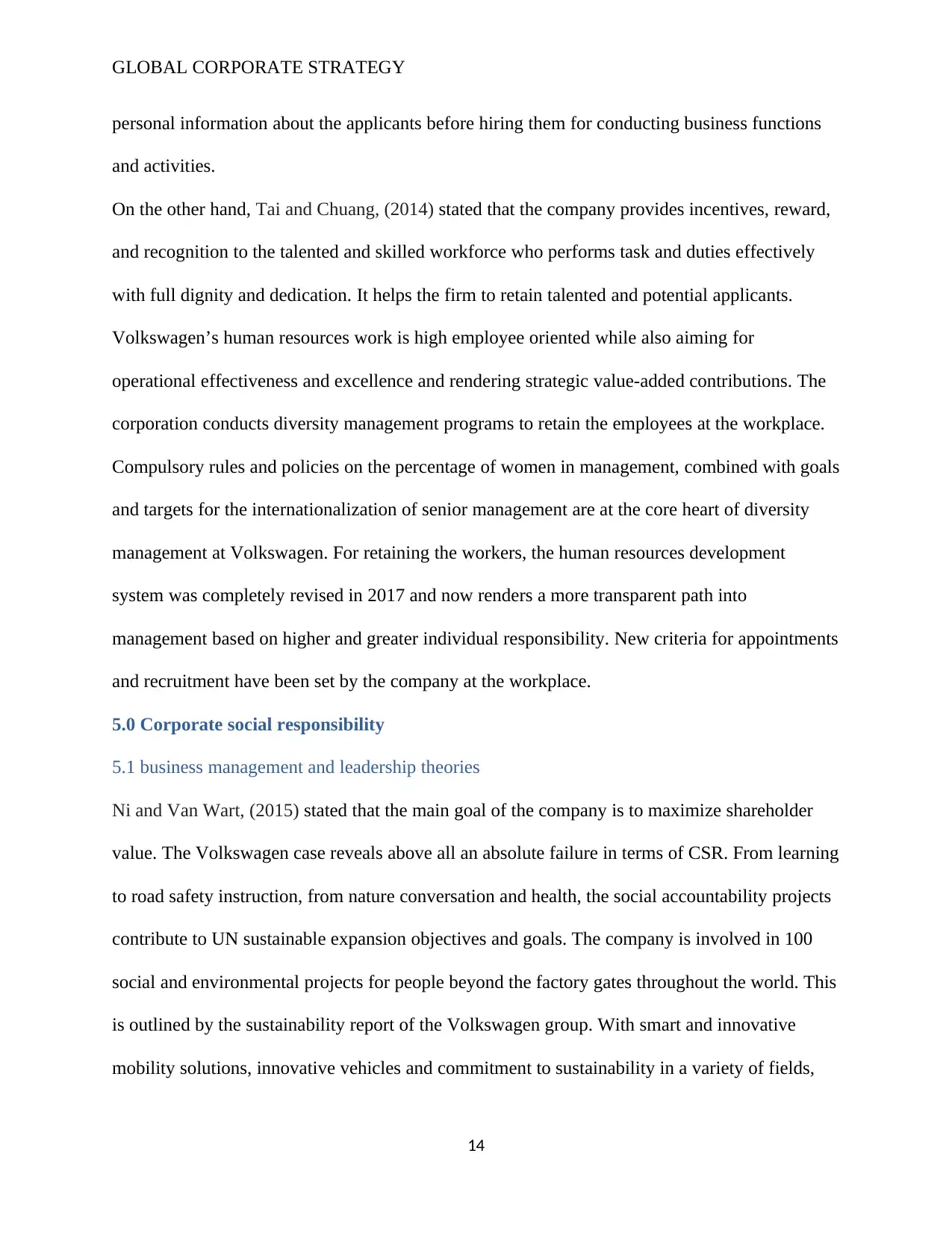
GLOBAL CORPORATE STRATEGY
personal information about the applicants before hiring them for conducting business functions
and activities.
On the other hand, Tai and Chuang, (2014) stated that the company provides incentives, reward,
and recognition to the talented and skilled workforce who performs task and duties effectively
with full dignity and dedication. It helps the firm to retain talented and potential applicants.
Volkswagen’s human resources work is high employee oriented while also aiming for
operational effectiveness and excellence and rendering strategic value-added contributions. The
corporation conducts diversity management programs to retain the employees at the workplace.
Compulsory rules and policies on the percentage of women in management, combined with goals
and targets for the internationalization of senior management are at the core heart of diversity
management at Volkswagen. For retaining the workers, the human resources development
system was completely revised in 2017 and now renders a more transparent path into
management based on higher and greater individual responsibility. New criteria for appointments
and recruitment have been set by the company at the workplace.
5.0 Corporate social responsibility
5.1 business management and leadership theories
Ni and Van Wart, (2015) stated that the main goal of the company is to maximize shareholder
value. The Volkswagen case reveals above all an absolute failure in terms of CSR. From learning
to road safety instruction, from nature conversation and health, the social accountability projects
contribute to UN sustainable expansion objectives and goals. The company is involved in 100
social and environmental projects for people beyond the factory gates throughout the world. This
is outlined by the sustainability report of the Volkswagen group. With smart and innovative
mobility solutions, innovative vehicles and commitment to sustainability in a variety of fields,
14
personal information about the applicants before hiring them for conducting business functions
and activities.
On the other hand, Tai and Chuang, (2014) stated that the company provides incentives, reward,
and recognition to the talented and skilled workforce who performs task and duties effectively
with full dignity and dedication. It helps the firm to retain talented and potential applicants.
Volkswagen’s human resources work is high employee oriented while also aiming for
operational effectiveness and excellence and rendering strategic value-added contributions. The
corporation conducts diversity management programs to retain the employees at the workplace.
Compulsory rules and policies on the percentage of women in management, combined with goals
and targets for the internationalization of senior management are at the core heart of diversity
management at Volkswagen. For retaining the workers, the human resources development
system was completely revised in 2017 and now renders a more transparent path into
management based on higher and greater individual responsibility. New criteria for appointments
and recruitment have been set by the company at the workplace.
5.0 Corporate social responsibility
5.1 business management and leadership theories
Ni and Van Wart, (2015) stated that the main goal of the company is to maximize shareholder
value. The Volkswagen case reveals above all an absolute failure in terms of CSR. From learning
to road safety instruction, from nature conversation and health, the social accountability projects
contribute to UN sustainable expansion objectives and goals. The company is involved in 100
social and environmental projects for people beyond the factory gates throughout the world. This
is outlined by the sustainability report of the Volkswagen group. With smart and innovative
mobility solutions, innovative vehicles and commitment to sustainability in a variety of fields,
14
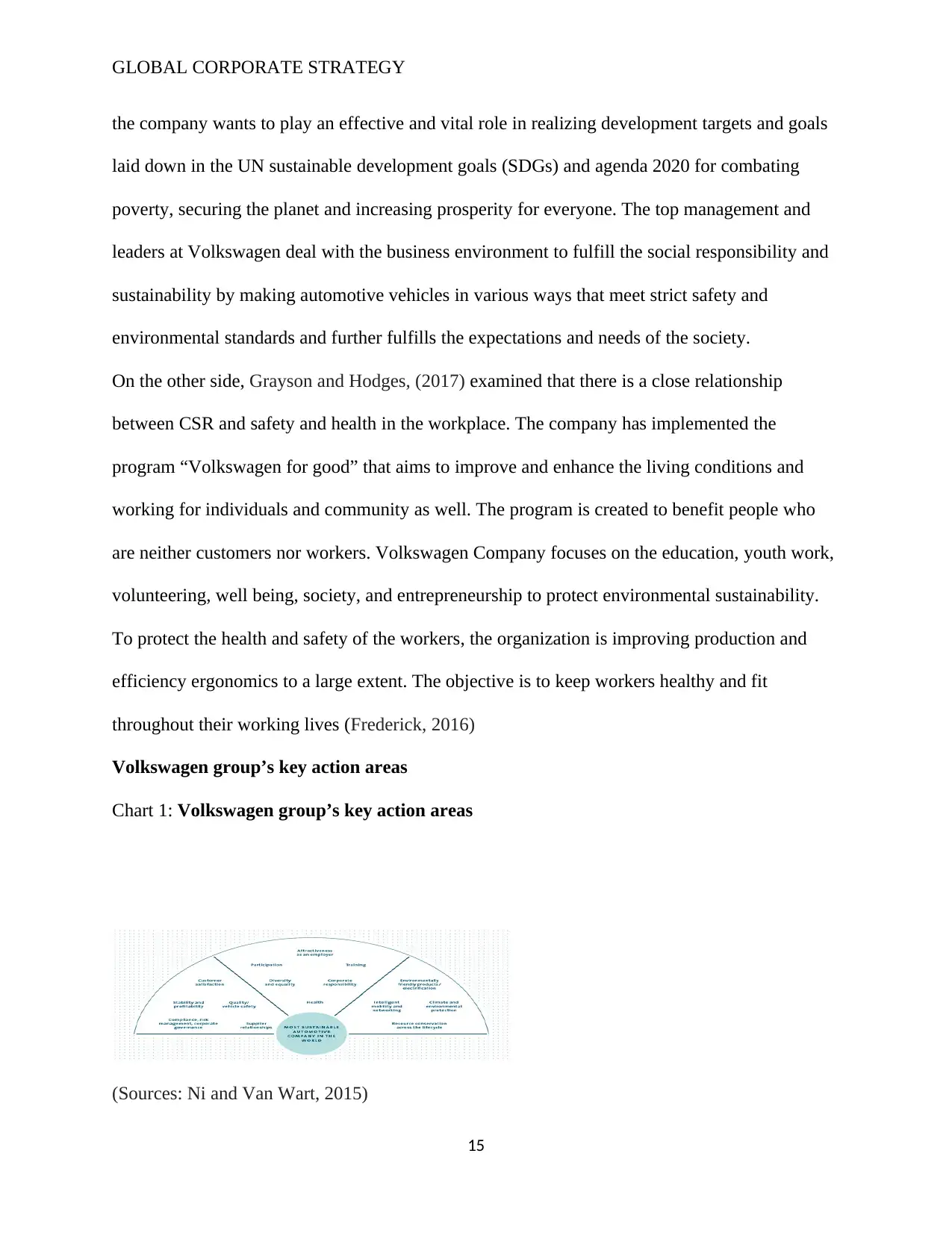
GLOBAL CORPORATE STRATEGY
the company wants to play an effective and vital role in realizing development targets and goals
laid down in the UN sustainable development goals (SDGs) and agenda 2020 for combating
poverty, securing the planet and increasing prosperity for everyone. The top management and
leaders at Volkswagen deal with the business environment to fulfill the social responsibility and
sustainability by making automotive vehicles in various ways that meet strict safety and
environmental standards and further fulfills the expectations and needs of the society.
On the other side, Grayson and Hodges, (2017) examined that there is a close relationship
between CSR and safety and health in the workplace. The company has implemented the
program “Volkswagen for good” that aims to improve and enhance the living conditions and
working for individuals and community as well. The program is created to benefit people who
are neither customers nor workers. Volkswagen Company focuses on the education, youth work,
volunteering, well being, society, and entrepreneurship to protect environmental sustainability.
To protect the health and safety of the workers, the organization is improving production and
efficiency ergonomics to a large extent. The objective is to keep workers healthy and fit
throughout their working lives (Frederick, 2016)
Volkswagen group’s key action areas
Chart 1: Volkswagen group’s key action areas
(Sources: Ni and Van Wart, 2015)
15
the company wants to play an effective and vital role in realizing development targets and goals
laid down in the UN sustainable development goals (SDGs) and agenda 2020 for combating
poverty, securing the planet and increasing prosperity for everyone. The top management and
leaders at Volkswagen deal with the business environment to fulfill the social responsibility and
sustainability by making automotive vehicles in various ways that meet strict safety and
environmental standards and further fulfills the expectations and needs of the society.
On the other side, Grayson and Hodges, (2017) examined that there is a close relationship
between CSR and safety and health in the workplace. The company has implemented the
program “Volkswagen for good” that aims to improve and enhance the living conditions and
working for individuals and community as well. The program is created to benefit people who
are neither customers nor workers. Volkswagen Company focuses on the education, youth work,
volunteering, well being, society, and entrepreneurship to protect environmental sustainability.
To protect the health and safety of the workers, the organization is improving production and
efficiency ergonomics to a large extent. The objective is to keep workers healthy and fit
throughout their working lives (Frederick, 2016)
Volkswagen group’s key action areas
Chart 1: Volkswagen group’s key action areas
(Sources: Ni and Van Wart, 2015)
15

GLOBAL CORPORATE STRATEGY
Conclusion
It is concluded from the above-mentioned analysis that Volkswagen Company needs to use
innovative strategies to prevent and handle the diesel gate scandal. Apart from this, the
organization uses porter five forces analysis to stand out over the rivals internationally.
Recruitment and retaining are the biggest functions of HRM at Volkswagen. Volkswagen uses
innovative recruitment and retention strategies to attract and retain the workforce globally. It is
worth noted from the above analysis that CSR activities and sustainability are essential to
provide value and worth to the stakeholders at Volkswagen.
16
Conclusion
It is concluded from the above-mentioned analysis that Volkswagen Company needs to use
innovative strategies to prevent and handle the diesel gate scandal. Apart from this, the
organization uses porter five forces analysis to stand out over the rivals internationally.
Recruitment and retaining are the biggest functions of HRM at Volkswagen. Volkswagen uses
innovative recruitment and retention strategies to attract and retain the workforce globally. It is
worth noted from the above analysis that CSR activities and sustainability are essential to
provide value and worth to the stakeholders at Volkswagen.
16
Secure Best Marks with AI Grader
Need help grading? Try our AI Grader for instant feedback on your assignments.
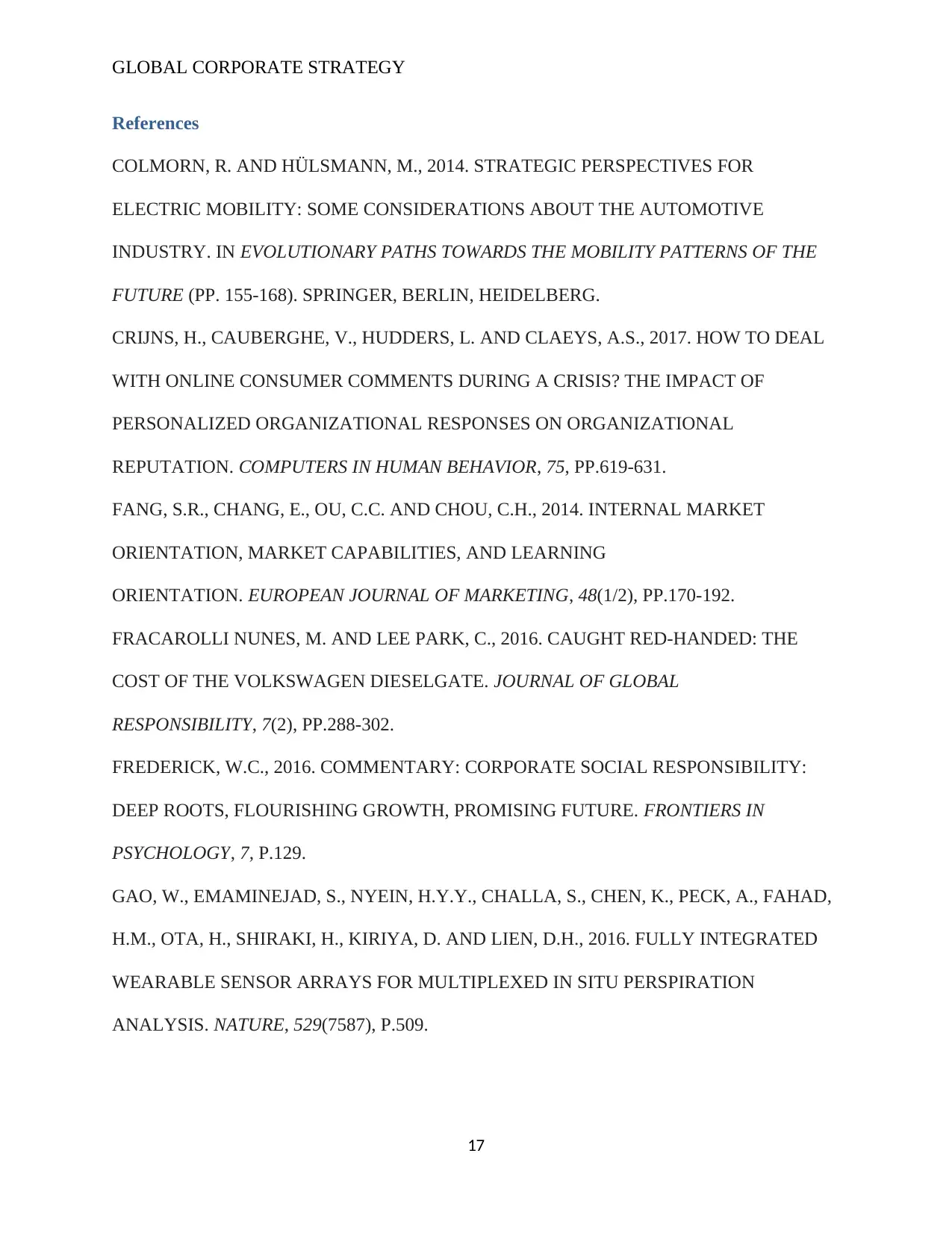
GLOBAL CORPORATE STRATEGY
References
COLMORN, R. AND HÜLSMANN, M., 2014. STRATEGIC PERSPECTIVES FOR
ELECTRIC MOBILITY: SOME CONSIDERATIONS ABOUT THE AUTOMOTIVE
INDUSTRY. IN EVOLUTIONARY PATHS TOWARDS THE MOBILITY PATTERNS OF THE
FUTURE (PP. 155-168). SPRINGER, BERLIN, HEIDELBERG.
CRIJNS, H., CAUBERGHE, V., HUDDERS, L. AND CLAEYS, A.S., 2017. HOW TO DEAL
WITH ONLINE CONSUMER COMMENTS DURING A CRISIS? THE IMPACT OF
PERSONALIZED ORGANIZATIONAL RESPONSES ON ORGANIZATIONAL
REPUTATION. COMPUTERS IN HUMAN BEHAVIOR, 75, PP.619-631.
FANG, S.R., CHANG, E., OU, C.C. AND CHOU, C.H., 2014. INTERNAL MARKET
ORIENTATION, MARKET CAPABILITIES, AND LEARNING
ORIENTATION. EUROPEAN JOURNAL OF MARKETING, 48(1/2), PP.170-192.
FRACAROLLI NUNES, M. AND LEE PARK, C., 2016. CAUGHT RED-HANDED: THE
COST OF THE VOLKSWAGEN DIESELGATE. JOURNAL OF GLOBAL
RESPONSIBILITY, 7(2), PP.288-302.
FREDERICK, W.C., 2016. COMMENTARY: CORPORATE SOCIAL RESPONSIBILITY:
DEEP ROOTS, FLOURISHING GROWTH, PROMISING FUTURE. FRONTIERS IN
PSYCHOLOGY, 7, P.129.
GAO, W., EMAMINEJAD, S., NYEIN, H.Y.Y., CHALLA, S., CHEN, K., PECK, A., FAHAD,
H.M., OTA, H., SHIRAKI, H., KIRIYA, D. AND LIEN, D.H., 2016. FULLY INTEGRATED
WEARABLE SENSOR ARRAYS FOR MULTIPLEXED IN SITU PERSPIRATION
ANALYSIS. NATURE, 529(7587), P.509.
17
References
COLMORN, R. AND HÜLSMANN, M., 2014. STRATEGIC PERSPECTIVES FOR
ELECTRIC MOBILITY: SOME CONSIDERATIONS ABOUT THE AUTOMOTIVE
INDUSTRY. IN EVOLUTIONARY PATHS TOWARDS THE MOBILITY PATTERNS OF THE
FUTURE (PP. 155-168). SPRINGER, BERLIN, HEIDELBERG.
CRIJNS, H., CAUBERGHE, V., HUDDERS, L. AND CLAEYS, A.S., 2017. HOW TO DEAL
WITH ONLINE CONSUMER COMMENTS DURING A CRISIS? THE IMPACT OF
PERSONALIZED ORGANIZATIONAL RESPONSES ON ORGANIZATIONAL
REPUTATION. COMPUTERS IN HUMAN BEHAVIOR, 75, PP.619-631.
FANG, S.R., CHANG, E., OU, C.C. AND CHOU, C.H., 2014. INTERNAL MARKET
ORIENTATION, MARKET CAPABILITIES, AND LEARNING
ORIENTATION. EUROPEAN JOURNAL OF MARKETING, 48(1/2), PP.170-192.
FRACAROLLI NUNES, M. AND LEE PARK, C., 2016. CAUGHT RED-HANDED: THE
COST OF THE VOLKSWAGEN DIESELGATE. JOURNAL OF GLOBAL
RESPONSIBILITY, 7(2), PP.288-302.
FREDERICK, W.C., 2016. COMMENTARY: CORPORATE SOCIAL RESPONSIBILITY:
DEEP ROOTS, FLOURISHING GROWTH, PROMISING FUTURE. FRONTIERS IN
PSYCHOLOGY, 7, P.129.
GAO, W., EMAMINEJAD, S., NYEIN, H.Y.Y., CHALLA, S., CHEN, K., PECK, A., FAHAD,
H.M., OTA, H., SHIRAKI, H., KIRIYA, D. AND LIEN, D.H., 2016. FULLY INTEGRATED
WEARABLE SENSOR ARRAYS FOR MULTIPLEXED IN SITU PERSPIRATION
ANALYSIS. NATURE, 529(7587), P.509.
17
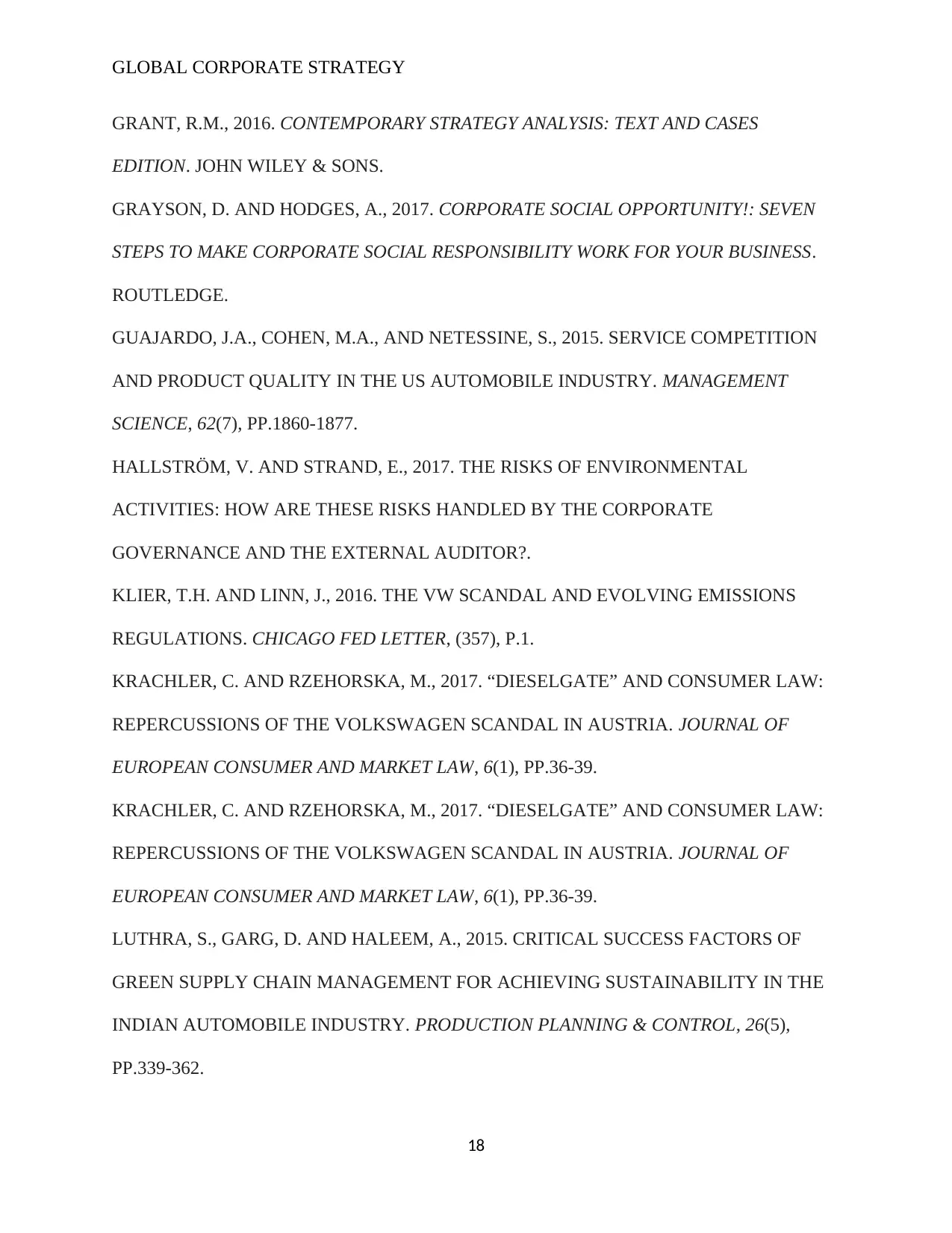
GLOBAL CORPORATE STRATEGY
GRANT, R.M., 2016. CONTEMPORARY STRATEGY ANALYSIS: TEXT AND CASES
EDITION. JOHN WILEY & SONS.
GRAYSON, D. AND HODGES, A., 2017. CORPORATE SOCIAL OPPORTUNITY!: SEVEN
STEPS TO MAKE CORPORATE SOCIAL RESPONSIBILITY WORK FOR YOUR BUSINESS.
ROUTLEDGE.
GUAJARDO, J.A., COHEN, M.A., AND NETESSINE, S., 2015. SERVICE COMPETITION
AND PRODUCT QUALITY IN THE US AUTOMOBILE INDUSTRY. MANAGEMENT
SCIENCE, 62(7), PP.1860-1877.
HALLSTRÖM, V. AND STRAND, E., 2017. THE RISKS OF ENVIRONMENTAL
ACTIVITIES: HOW ARE THESE RISKS HANDLED BY THE CORPORATE
GOVERNANCE AND THE EXTERNAL AUDITOR?.
KLIER, T.H. AND LINN, J., 2016. THE VW SCANDAL AND EVOLVING EMISSIONS
REGULATIONS. CHICAGO FED LETTER, (357), P.1.
KRACHLER, C. AND RZEHORSKA, M., 2017. “DIESELGATE” AND CONSUMER LAW:
REPERCUSSIONS OF THE VOLKSWAGEN SCANDAL IN AUSTRIA. JOURNAL OF
EUROPEAN CONSUMER AND MARKET LAW, 6(1), PP.36-39.
KRACHLER, C. AND RZEHORSKA, M., 2017. “DIESELGATE” AND CONSUMER LAW:
REPERCUSSIONS OF THE VOLKSWAGEN SCANDAL IN AUSTRIA. JOURNAL OF
EUROPEAN CONSUMER AND MARKET LAW, 6(1), PP.36-39.
LUTHRA, S., GARG, D. AND HALEEM, A., 2015. CRITICAL SUCCESS FACTORS OF
GREEN SUPPLY CHAIN MANAGEMENT FOR ACHIEVING SUSTAINABILITY IN THE
INDIAN AUTOMOBILE INDUSTRY. PRODUCTION PLANNING & CONTROL, 26(5),
PP.339-362.
18
GRANT, R.M., 2016. CONTEMPORARY STRATEGY ANALYSIS: TEXT AND CASES
EDITION. JOHN WILEY & SONS.
GRAYSON, D. AND HODGES, A., 2017. CORPORATE SOCIAL OPPORTUNITY!: SEVEN
STEPS TO MAKE CORPORATE SOCIAL RESPONSIBILITY WORK FOR YOUR BUSINESS.
ROUTLEDGE.
GUAJARDO, J.A., COHEN, M.A., AND NETESSINE, S., 2015. SERVICE COMPETITION
AND PRODUCT QUALITY IN THE US AUTOMOBILE INDUSTRY. MANAGEMENT
SCIENCE, 62(7), PP.1860-1877.
HALLSTRÖM, V. AND STRAND, E., 2017. THE RISKS OF ENVIRONMENTAL
ACTIVITIES: HOW ARE THESE RISKS HANDLED BY THE CORPORATE
GOVERNANCE AND THE EXTERNAL AUDITOR?.
KLIER, T.H. AND LINN, J., 2016. THE VW SCANDAL AND EVOLVING EMISSIONS
REGULATIONS. CHICAGO FED LETTER, (357), P.1.
KRACHLER, C. AND RZEHORSKA, M., 2017. “DIESELGATE” AND CONSUMER LAW:
REPERCUSSIONS OF THE VOLKSWAGEN SCANDAL IN AUSTRIA. JOURNAL OF
EUROPEAN CONSUMER AND MARKET LAW, 6(1), PP.36-39.
KRACHLER, C. AND RZEHORSKA, M., 2017. “DIESELGATE” AND CONSUMER LAW:
REPERCUSSIONS OF THE VOLKSWAGEN SCANDAL IN AUSTRIA. JOURNAL OF
EUROPEAN CONSUMER AND MARKET LAW, 6(1), PP.36-39.
LUTHRA, S., GARG, D. AND HALEEM, A., 2015. CRITICAL SUCCESS FACTORS OF
GREEN SUPPLY CHAIN MANAGEMENT FOR ACHIEVING SUSTAINABILITY IN THE
INDIAN AUTOMOBILE INDUSTRY. PRODUCTION PLANNING & CONTROL, 26(5),
PP.339-362.
18

GLOBAL CORPORATE STRATEGY
LUTHRA, S., GARG, D. AND HALEEM, A., 2016. THE IMPACTS OF CRITICAL SUCCESS
FACTORS FOR IMPLEMENTING GREEN SUPPLY CHAIN MANAGEMENT TOWARDS
SUSTAINABILITY: AN EMPIRICAL INVESTIGATION OF THE INDIAN AUTOMOBILE
INDUSTRY. JOURNAL OF CLEANER PRODUCTION, 121, PP.142-158.
MADURASINGHE, V.W., 2016. GUIDELINES FOR REPORTING EMBEDDED
RECRUITMENT TRIALS. TRIALS, 17(1), P.27.
NI, A. AND VAN WART, M., 2015. CORPORATE SOCIAL RESPONSIBILITY: DOING
WELL AND DOING GOOD. IN BUILDING BUSINESS-GOVERNMENT RELATIONS (PP.
175-196). ROUTLEDGE.
QIAN, X.Y., LIU, Y.M., JIANG, Z.Q., PODOBNIK, B., ZHOU, W.X. AND STANLEY, H.E.,
2015. DETRENDED PARTIAL CROSS-CORRELATION ANALYSIS OF TWO
NONSTATIONARY TIME SERIES INFLUENCED BY COMMON EXTERNAL
FORCES. PHYSICAL REVIEW E, 91(6), P.062816.
ROTHAERMEL, F.T., 2015. STRATEGIC MANAGEMENT. MCGRAW-HILL EDUCATION,
SCHWARTZ, M.S., 2017. CORPORATE SOCIAL RESPONSIBILITY. UK: ROUTLEDGE.
SIANO, A., VOLLERO, A., CONTE, F., AND AMABILE, S., 2017. “MORE THAN
WORDS”: EXPANDING THE TAXONOMY OF GREENWASHING AFTER THE
VOLKSWAGEN SCANDAL. JOURNAL OF BUSINESS RESEARCH, 71, PP.27-37.
SPAPENS, T., 2018. THE ‘DIESELGATE’SCANDAL: A CRIMINOLOGICAL
PERSPECTIVE. IN GREEN CRIMES AND DIRTY MONEY (PP. 109-130). ROUTLEDGE.
STANWICK, P. AND STANWICK, S., 2017. VOLKSWAGEN EMISSIONS SCANDAL: THE
PERILS OF INSTALLING ILLEGAL SOFTWARE. INTERNATIONAL REVIEW OF
MANAGEMENT AND BUSINESS RESEARCH, 6(1), P.18.
19
LUTHRA, S., GARG, D. AND HALEEM, A., 2016. THE IMPACTS OF CRITICAL SUCCESS
FACTORS FOR IMPLEMENTING GREEN SUPPLY CHAIN MANAGEMENT TOWARDS
SUSTAINABILITY: AN EMPIRICAL INVESTIGATION OF THE INDIAN AUTOMOBILE
INDUSTRY. JOURNAL OF CLEANER PRODUCTION, 121, PP.142-158.
MADURASINGHE, V.W., 2016. GUIDELINES FOR REPORTING EMBEDDED
RECRUITMENT TRIALS. TRIALS, 17(1), P.27.
NI, A. AND VAN WART, M., 2015. CORPORATE SOCIAL RESPONSIBILITY: DOING
WELL AND DOING GOOD. IN BUILDING BUSINESS-GOVERNMENT RELATIONS (PP.
175-196). ROUTLEDGE.
QIAN, X.Y., LIU, Y.M., JIANG, Z.Q., PODOBNIK, B., ZHOU, W.X. AND STANLEY, H.E.,
2015. DETRENDED PARTIAL CROSS-CORRELATION ANALYSIS OF TWO
NONSTATIONARY TIME SERIES INFLUENCED BY COMMON EXTERNAL
FORCES. PHYSICAL REVIEW E, 91(6), P.062816.
ROTHAERMEL, F.T., 2015. STRATEGIC MANAGEMENT. MCGRAW-HILL EDUCATION,
SCHWARTZ, M.S., 2017. CORPORATE SOCIAL RESPONSIBILITY. UK: ROUTLEDGE.
SIANO, A., VOLLERO, A., CONTE, F., AND AMABILE, S., 2017. “MORE THAN
WORDS”: EXPANDING THE TAXONOMY OF GREENWASHING AFTER THE
VOLKSWAGEN SCANDAL. JOURNAL OF BUSINESS RESEARCH, 71, PP.27-37.
SPAPENS, T., 2018. THE ‘DIESELGATE’SCANDAL: A CRIMINOLOGICAL
PERSPECTIVE. IN GREEN CRIMES AND DIRTY MONEY (PP. 109-130). ROUTLEDGE.
STANWICK, P. AND STANWICK, S., 2017. VOLKSWAGEN EMISSIONS SCANDAL: THE
PERILS OF INSTALLING ILLEGAL SOFTWARE. INTERNATIONAL REVIEW OF
MANAGEMENT AND BUSINESS RESEARCH, 6(1), P.18.
19
Paraphrase This Document
Need a fresh take? Get an instant paraphrase of this document with our AI Paraphraser
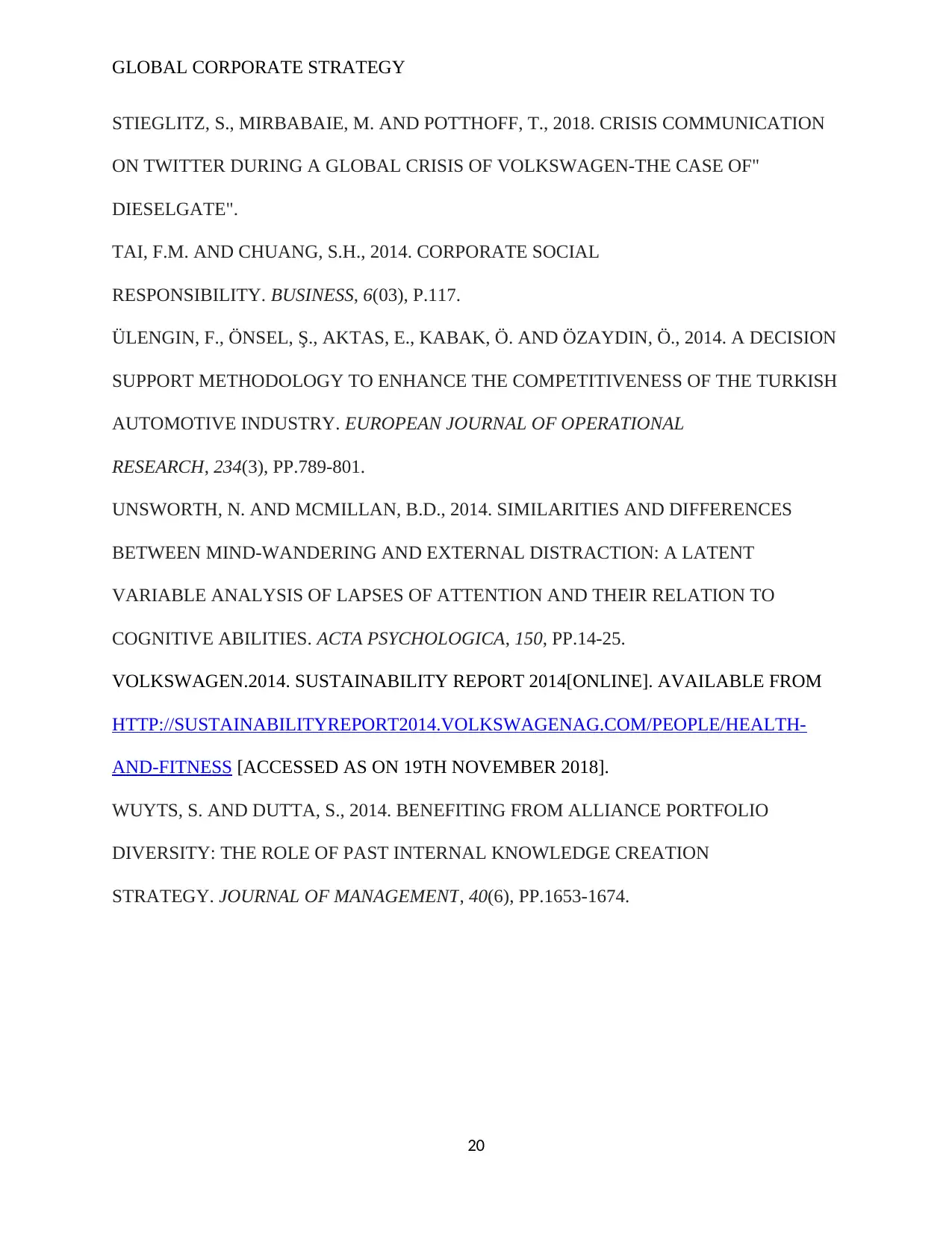
GLOBAL CORPORATE STRATEGY
STIEGLITZ, S., MIRBABAIE, M. AND POTTHOFF, T., 2018. CRISIS COMMUNICATION
ON TWITTER DURING A GLOBAL CRISIS OF VOLKSWAGEN-THE CASE OF"
DIESELGATE".
TAI, F.M. AND CHUANG, S.H., 2014. CORPORATE SOCIAL
RESPONSIBILITY. BUSINESS, 6(03), P.117.
ÜLENGIN, F., ÖNSEL, Ş., AKTAS, E., KABAK, Ö. AND ÖZAYDIN, Ö., 2014. A DECISION
SUPPORT METHODOLOGY TO ENHANCE THE COMPETITIVENESS OF THE TURKISH
AUTOMOTIVE INDUSTRY. EUROPEAN JOURNAL OF OPERATIONAL
RESEARCH, 234(3), PP.789-801.
UNSWORTH, N. AND MCMILLAN, B.D., 2014. SIMILARITIES AND DIFFERENCES
BETWEEN MIND-WANDERING AND EXTERNAL DISTRACTION: A LATENT
VARIABLE ANALYSIS OF LAPSES OF ATTENTION AND THEIR RELATION TO
COGNITIVE ABILITIES. ACTA PSYCHOLOGICA, 150, PP.14-25.
VOLKSWAGEN.2014. SUSTAINABILITY REPORT 2014[ONLINE]. AVAILABLE FROM
HTTP://SUSTAINABILITYREPORT2014.VOLKSWAGENAG.COM/PEOPLE/HEALTH-
AND-FITNESS [ACCESSED AS ON 19TH NOVEMBER 2018].
WUYTS, S. AND DUTTA, S., 2014. BENEFITING FROM ALLIANCE PORTFOLIO
DIVERSITY: THE ROLE OF PAST INTERNAL KNOWLEDGE CREATION
STRATEGY. JOURNAL OF MANAGEMENT, 40(6), PP.1653-1674.
20
STIEGLITZ, S., MIRBABAIE, M. AND POTTHOFF, T., 2018. CRISIS COMMUNICATION
ON TWITTER DURING A GLOBAL CRISIS OF VOLKSWAGEN-THE CASE OF"
DIESELGATE".
TAI, F.M. AND CHUANG, S.H., 2014. CORPORATE SOCIAL
RESPONSIBILITY. BUSINESS, 6(03), P.117.
ÜLENGIN, F., ÖNSEL, Ş., AKTAS, E., KABAK, Ö. AND ÖZAYDIN, Ö., 2014. A DECISION
SUPPORT METHODOLOGY TO ENHANCE THE COMPETITIVENESS OF THE TURKISH
AUTOMOTIVE INDUSTRY. EUROPEAN JOURNAL OF OPERATIONAL
RESEARCH, 234(3), PP.789-801.
UNSWORTH, N. AND MCMILLAN, B.D., 2014. SIMILARITIES AND DIFFERENCES
BETWEEN MIND-WANDERING AND EXTERNAL DISTRACTION: A LATENT
VARIABLE ANALYSIS OF LAPSES OF ATTENTION AND THEIR RELATION TO
COGNITIVE ABILITIES. ACTA PSYCHOLOGICA, 150, PP.14-25.
VOLKSWAGEN.2014. SUSTAINABILITY REPORT 2014[ONLINE]. AVAILABLE FROM
HTTP://SUSTAINABILITYREPORT2014.VOLKSWAGENAG.COM/PEOPLE/HEALTH-
AND-FITNESS [ACCESSED AS ON 19TH NOVEMBER 2018].
WUYTS, S. AND DUTTA, S., 2014. BENEFITING FROM ALLIANCE PORTFOLIO
DIVERSITY: THE ROLE OF PAST INTERNAL KNOWLEDGE CREATION
STRATEGY. JOURNAL OF MANAGEMENT, 40(6), PP.1653-1674.
20
1 out of 20
Your All-in-One AI-Powered Toolkit for Academic Success.
+13062052269
info@desklib.com
Available 24*7 on WhatsApp / Email
![[object Object]](/_next/static/media/star-bottom.7253800d.svg)
Unlock your academic potential
© 2024 | Zucol Services PVT LTD | All rights reserved.
